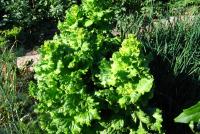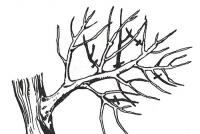What to plant along the house. Decorative design of a garden path with their own hands
Acquiring suburban housing or choosing a country house as a place of rest, the owner gives greenery, plants, flowers an important place in his life.
He uses them to recuperate, take a break from the turmoil of days and as a way to relax. In order for the country space to really contribute to relaxation, you need to organize it and make it appropriate for the assigned tasks. In this case, large tasks are placed on the trees and shrubs along the fence and paths.
They fill the world around with joy, their appearance delights a person, vegetable oases are used to decorate life. The peculiarity of trees and shrubs is that they can be used not only as decorative elements to decorate the landscape, but are able to bear fruit, replenish vitamins and minerals, which is important for the suburban area and the family living here.
Hedge along the tracks
It is impossible to imagine the world of man devoid of vegetation: shrubs and trees. They not only affect the psychological and emotional state of all living things, but also determine the level of human health. Plants give us the most important element for the existence and health of oxygen.
Where to begin?
Experts advise to plan and place trees and shrubs along the fence and paths immediately, simultaneously with the planning of suburban construction. An integrated approach to the organization and filling of the space will allow the dacha to the end of construction work to acquire a habitable appearance, fill with greenery and look like a real kingdom of nature.

Plan of the site with the location of shrubs
Before starting the greening of the territory, inspect the area, familiarize yourself with its advantages and pay attention to the disadvantages, evaluate the possibilities and conditions for planting. It is very important for the selection of varieties and varieties of trees and shrubs.
When arranging a country territory, in order to observe the harmony of all the components and get a finished space, it is better to pay attention and be guided by the recommendations developed by specialists. Before deciding which plantings will grow near the fence, which bushes inside the territory, you need to pay attention to the country space and get answers to the following questions:
1. Decide on the purpose of bushes and trees used for landscaping the site. Understand what purpose is set when landing: to close an ugly fence or to decorate a charming structure. Choose which main function the plants will carry: to mask the fence or to harmoniously adjoin it.
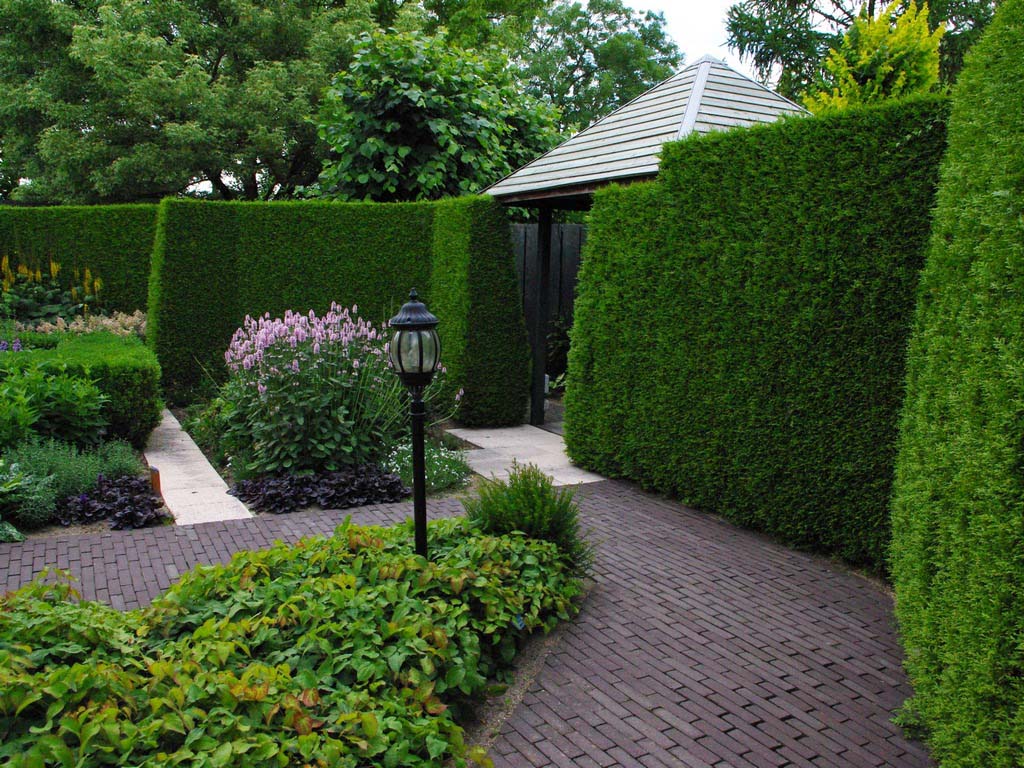
Masking the fence with shrubs
2. For yourself, establish how much of the space falls under the power of trees and shrubs, how much it costs to leave free space. Do not overload the site. Excessive loading of trees and shrubs along the fence, especially plants of high forms, will visually reduce the area and make it oversaturated.
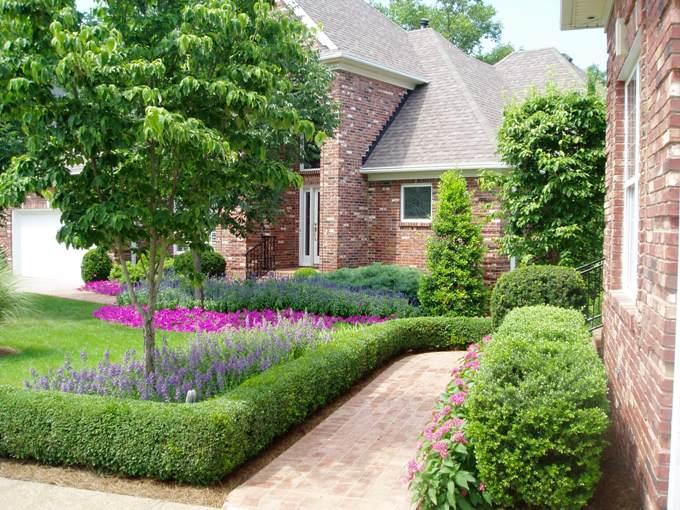
Shrub along the tracks should not overload the space
3. Determine which side of the fence is available for planting: brightly lit by the sun or constantly in the shade. When planting trees, focus on the shade cast by the fence, and plant plants that grow well in these shadow conditions.

Barberry bushes perfectly tolerate the shadow
4. What is the soil in the area of future planting? In order for a plant to truly reveal its decorative properties, it must grow in comfortable conditions for itself.
5. How much is expected subsequent care of the plant. Is it possible to provide with constant attention the capricious flora, provide pruning and shaping to trees and shrubs in need?

A hedge needs regular maintenance.
There are two options for the formation of vegetation on the plot:
1. When landscape planning does not require special human participation. This method of territory formation is particularly well suited for areas located on uneven terrain. In this case, due to the natural difference in the levels of the plant, they look beautiful and together form interesting compositions.
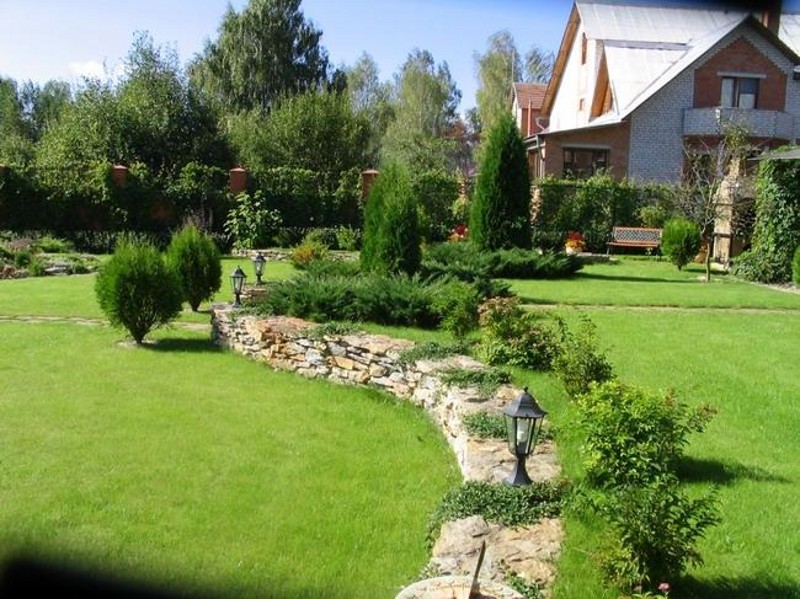
Free landscape planning area
2. The geometric layout provides for the exposure of certain distances between shrubs and trees, maintaining strict geometric shapes. Most often in this case, rows of densely planted trees are created. Between the rows provides for an empty space and standing alone vertical plants among the site.
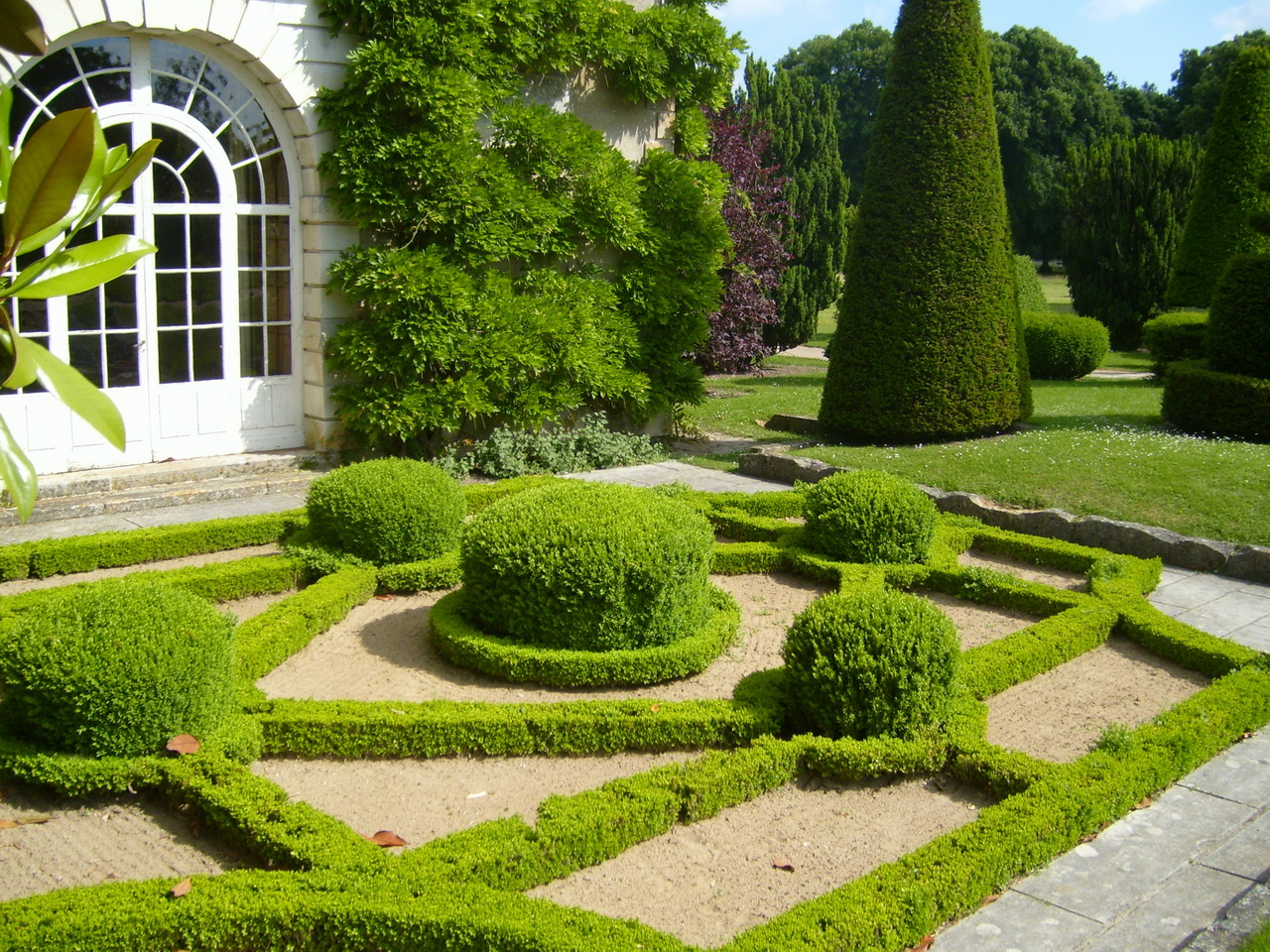
Strict geometric layout
What plants to plant at the fence?
Choosing trees and shrubs along the fence and paths, pay attention to the fence itself, its appearance and quality of the materials used. To choose plants that will be located in the immediate vicinity of the fence, you must build on its characteristics:
Rabitz
The chain-link refers to unstable structures. It is impossible to put a powerful shrub or a climbing vine on top of an unfortified fence; they will certainly destroy the fence. But on the other hand a transparent fence on the site refers to undesirable species.
![]()
Rabbit fence on the plot
The frequent life of a family living in a country house should not be in the public domain and needs some kind of cover. For planting in this case, suitable bushes that are able to support themselves and create an obstacle for prying eyes: lilac, irga, thuja.
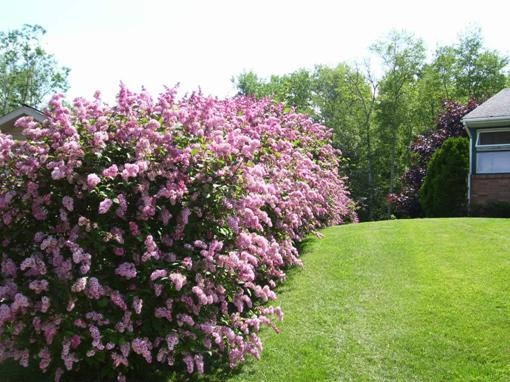
Lilac bushes close unsightly rabbits fence
Planted bushes of barberry, chokeberry or hawthorn planted near the fence look good. Plants are planted at a distance of up to a meter from the fence into the hole, the planting depth is from 0.5 m.
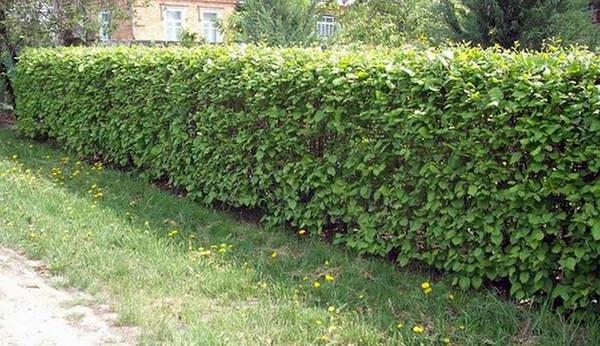
Hawthorn bushes in the design of the fence
Wooden fence
You can plant any shrubs and trees near the wooden fence. This is a great place for fruit seedlings and climbing shrubs such as hops. The only limitation in the need for constant care and the difficulties encountered with the execution of works on painting and maintenance of wooden fencing.

Curly shrub goes well with a wooden fence
Fence of corrugated
It is believed that the metal sheeting is a rather unsafe structure for delicate plants. In the course of a hot day, it heats up to high temperatures, and not all shrubs and trees can withstand such a hot neighborhood. But this opinion is disputed by the plants themselves. Near profiled sheeting lilac grows well, jasmine takes root, raspberry feels confident. Its surface is easily twisted vines.
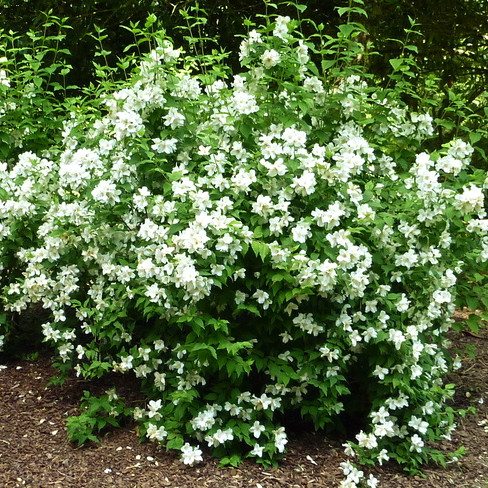
Jasmine bushes can be planted next to the fence of corrugated
Shrubs along the fence
When choosing shrubs and trees for a country plot, you can create not only luxurious greens. Provide for the planting of environmentally friendly and healthy fruit plants that will be an additional source of trace elements and vitamins. Pay attention to trees and shrubs that do not require special care and grow easily in your area.

A raspberry hedge is not only beautiful, but also useful
A beautiful solution - the creation of a fence from the neighbors in the form of a hedge. With good care, the bushes form a solid wall, which is desirable to periodically cut and at the same time you can give it an interesting shape. It is assumed that the shrub will grow to a sufficient height over time, close the branches and will look like a living fence. The only obstacle in the desire of bushes to expand the scope of their habitat. In this case, shrubs need to constantly cut and not allow them to conquer the entire suburban area.
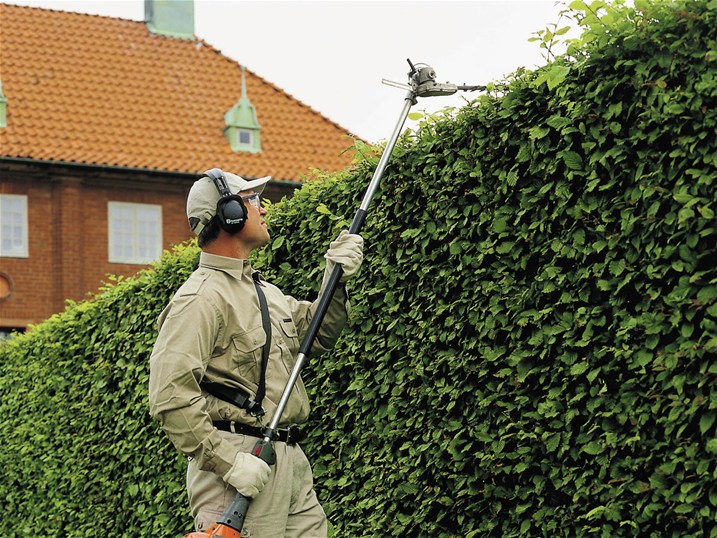
You can independently adjust the height of the fence.
You can use the same type of shrub. Having landed plants of different height and color, you will receive a picturesque wall that will have a unique look twice a year: during the flowering period and in autumn. The abundance of colors will fill your country space with unique beauty.
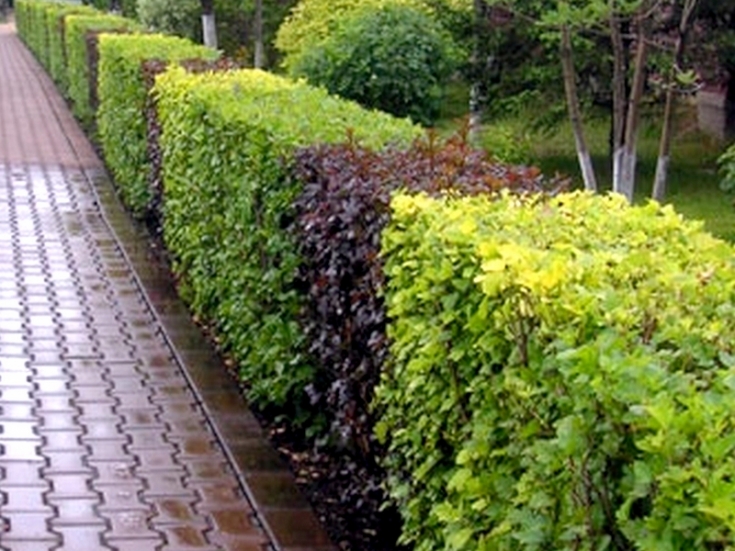
Bushes along the tracks of different colors
Thuja, lilac, hydrangea and spirea are suitable for hedge. When choosing plants, note that some of them do not like to be around. So, for example, barberry and turf badly coexist with each other.
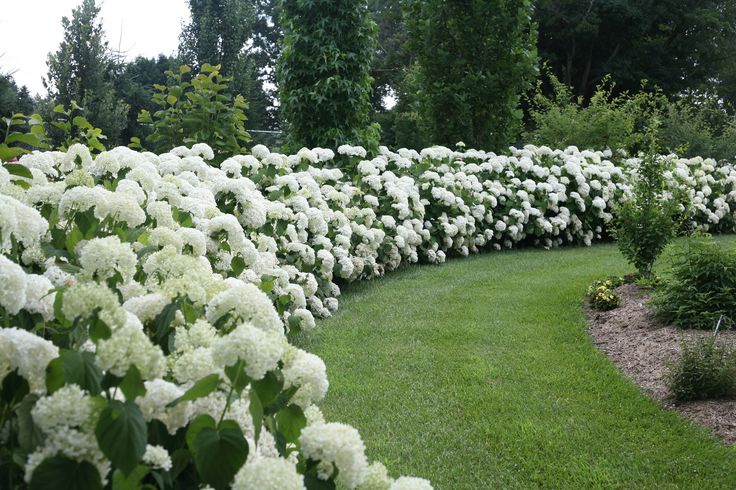
Fluffy hydrangea bushes along the walkway
A good idea at first glance to plant shrubs with berries suitable for food, the fence does not always seem successful afterwards. Fruiting plants quickly take root and begin to capture the nearby space, while the berries remain small and sour. When choosing a plot near a fence for fruit bushes such as currants, raspberries, and blackberries, it is necessary to take measures to limit their growth.
![]()
Cutting bushes along the fence
To do this, immediately behind the selected area is better to provide a lawn. Caring for shrubs is tying and cutting old branches. Plants also need weeding and killing weeds near the root. This must be done once a month.
Shrubs along the tracks
The decoration of the tracks with a lively ribbon of plants looks very beautiful and adorns the territory. It is not necessary to create a continuous strip of low shrub. This landing will require special attention and care. It is enough to create small thickets of bushes around the tracks, such as boxwood in the southern regions, low thuja. At the corners of the walkway, you can experiment, lay down a hill of stones or one large boulder, and place a row of creeping juniper alongside.
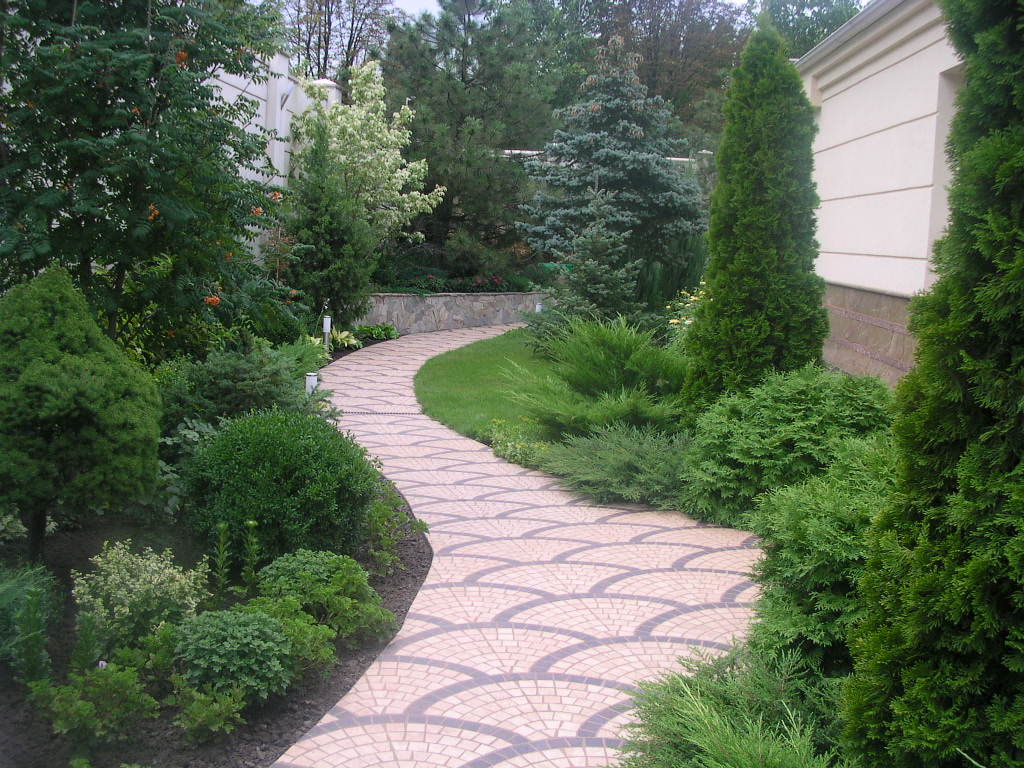
Shrubs of various types along the path
1. Trees should be located as far from the path as possible, up to 1.5 m. Otherwise, their roots can violate the integrity of the coating, and the crown can interfere with the movement of people.
2. Shrubs planted at a distance of one meter.
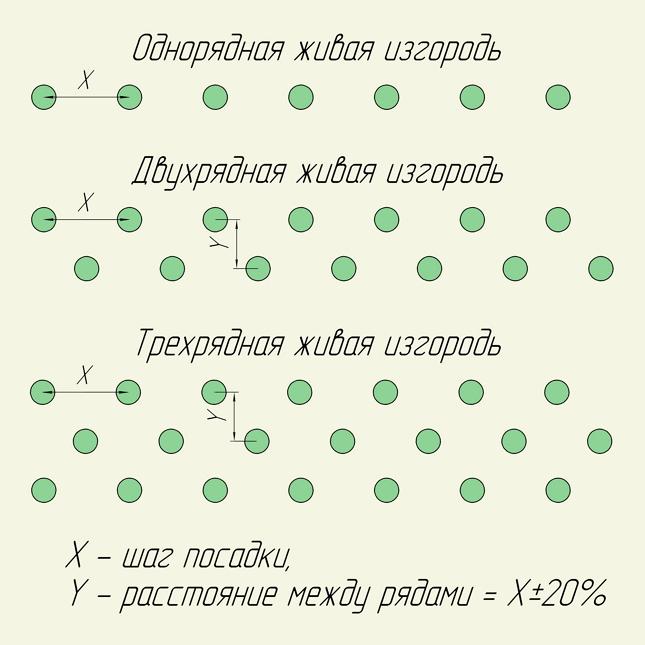
The distance between the shrubs in the hedge
3. Shrubs and trees, it is desirable to have an increasing height from south to north. In this case, the plants will not close each other from the sun.
Rules for planting trees and shrubs along the fence and paths
When landscaping, the main thing is to correctly form all the plants and link them into a single whole. In this case, all the vegetation will be in the field of view of man. All the colorful variety will be available for viewing and aesthetic pleasure.
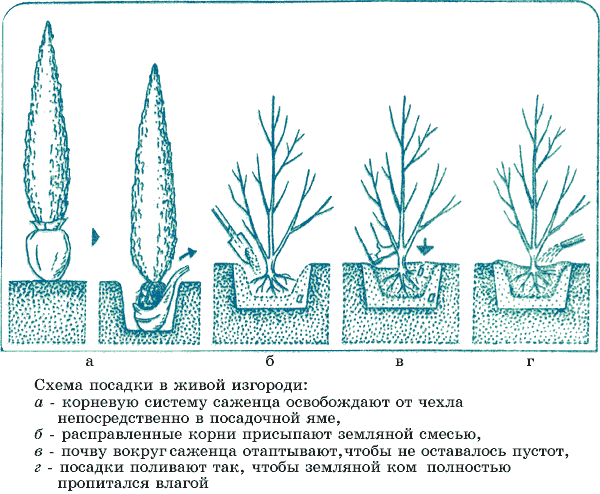
Scheme of planting shrubs along the fence
In the spring you will get a real fairy tale of flowers, petals and young greens, which will be able to unite on a site scale into a single fresh composition. And the look of the autumn colorful palette, consisting of all the famous shades of green, brown, yellow, red and orange, will shock you. For this it is important that the following conditions are met:
2. Nearby trees and shrubs should not have high, covering the entire overview of the forms.
3. Vegetation should not be the same in color and height, unless it should be a creative decision of the designer.
4. The diverse plant world, creating a riot of colors and heights on the spot, looks more interesting.

Planting table formed hedges
What to plant on the back of the fence?
When planting shrubs and trees from the front side of the fence, the owner tries not only to disguise home ownership from prying prying eyes. The creation of an attractive courtyard area is considered important. But do not give preference to fruit plants, hundreds of small legs can trample flower beds in pursuit of delicious fruit.

Flowering lilac bushes along the back of the fence
When planting tree saplings, note that over time they grow into tall trees that break communications, create a large shadow zone, and may eventually root out from gusts of wind and destroy everything in their path of fall.
Planting time of trees and shrubs along the fence and paths
In order for plants to successfully survive the winter period, saturated with low temperatures and wind power, listen to the advice of specialists when planting and pay attention to the following points:
1. When planting trees and shrubs, retreat from the fence to the required distance for plant development. Otherwise, the roots can destroy the barrier, and the crown shade the neighboring area, rather than cause displeasure of the neighbors. The distance from a fence for a tree equal to 3 m, for a bush in 1,5m is generally accepted.
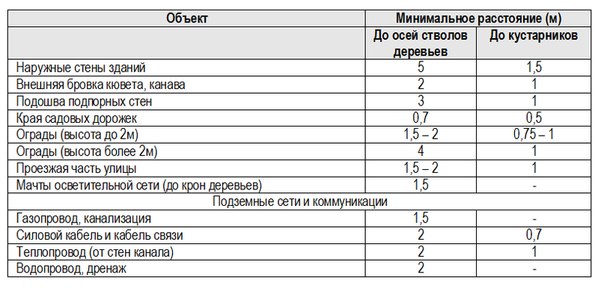
Table of distances between plantings
2. Big trees move away from the fence for at least 5 m. They subsequently form a powerful crown, grow well above the fence.
3. When planting plants, you need to ensure that there are no places with air stagnation in the area. During winter frosts, seedlings in this area may freeze.
4. It is also necessary to retreat from the apartment building about seven meters, otherwise the tree can destroy the foundation by its roots.
5. When landing, retreat a considerable distance from the water supply.
6. Do not allow trees and shrubs, especially those giving edible fruits, near the drain hole.
The most acceptable time to plant trees and shrubs along a fence and paths is generally considered to be autumn. There is such a rule that shrubs and trees that bloom in spring are best planted in the ground in autumn. In spring, vegetation, which blooms in late summer, takes root well.

Shrubs planting scheme
Based on these recommendations, planting plants is better to move to the autumn period. This should be done before the frost, it is desirable that the plant had time to take root. Most often, a transplant is performed in October. If there is a need to do it later, but the frost has not yet come, you can do the work, but provide additional insulation. To do this, near the trunk perform filling with sawdust or peat.
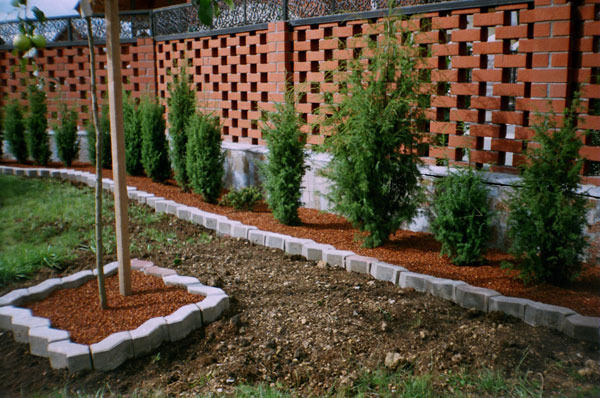
Mulching bushes along the fence sawdust
It is not recommended to replant trees and shrubs during frosts. It is better to just prikopat them in an inclined position, while covering the root with a layer of peat and earth, and planting in springtime.

Prikopka seedlings for the winter
Choosing for planting trees and shrubs along the fence and paths, take note of the recommendations given in the article. They will help you to properly organize the green space of the suburban area. Get aesthetic pleasure, relaxation and enjoyment of suburban life.
Photo gallery - trees and shrubs along the fence and paths

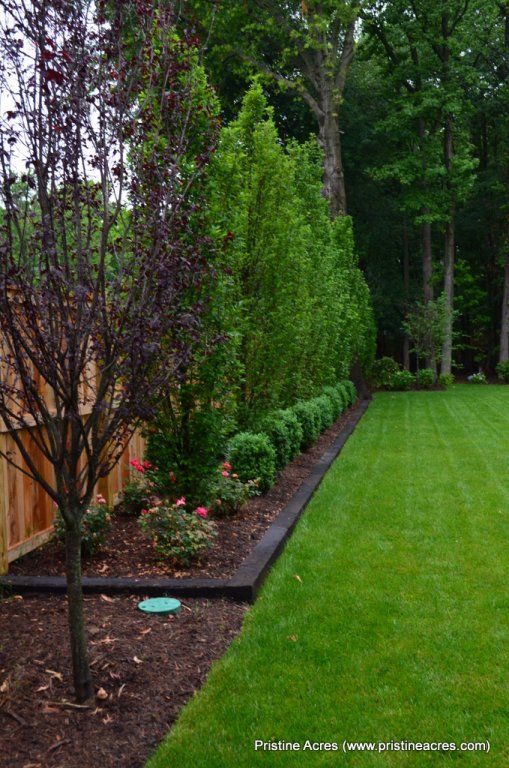
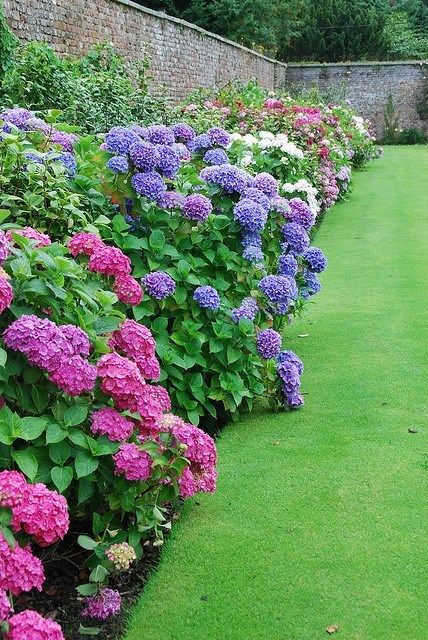
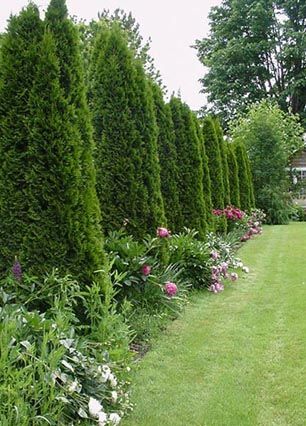
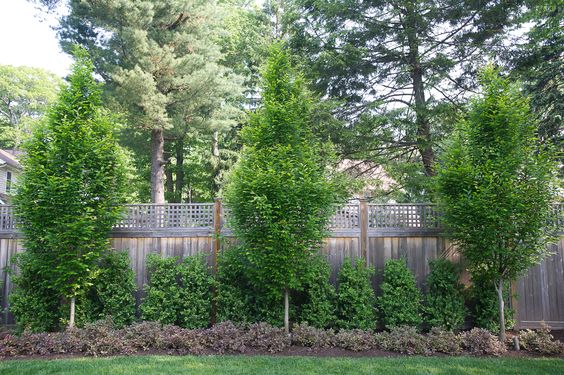
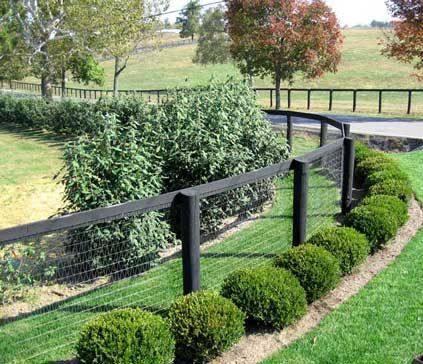
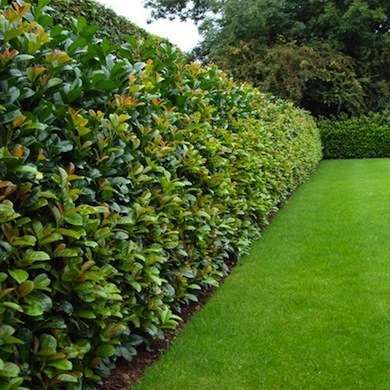
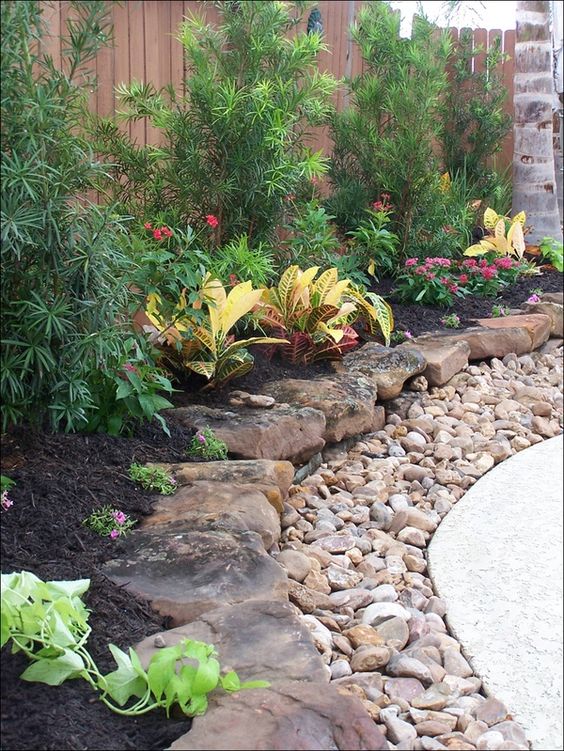
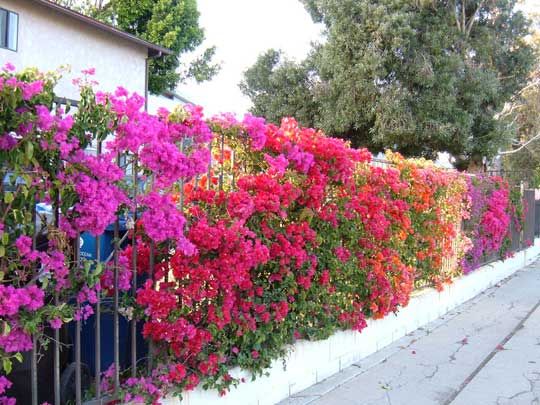


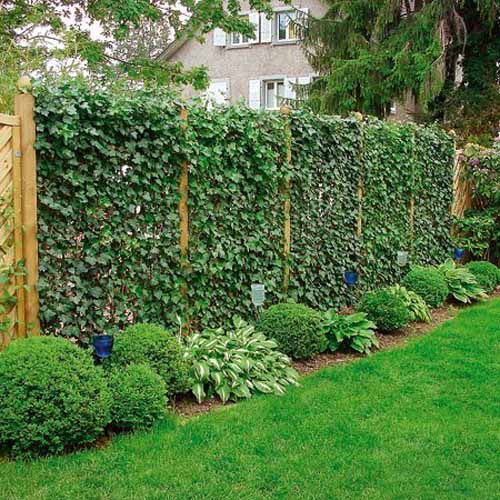
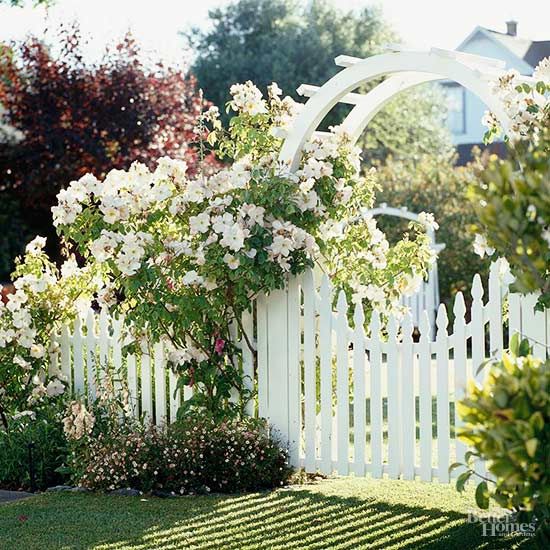
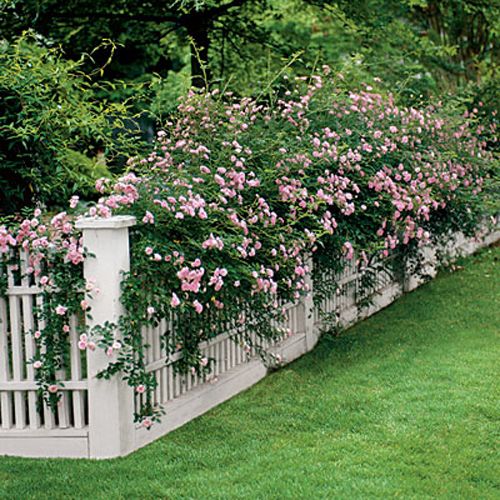
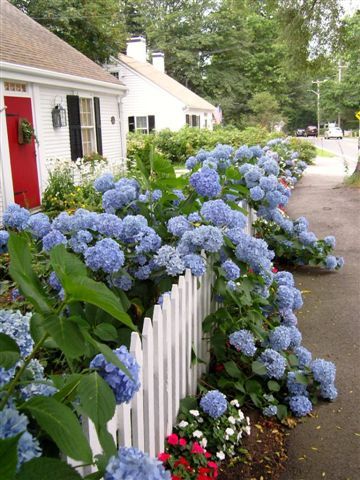
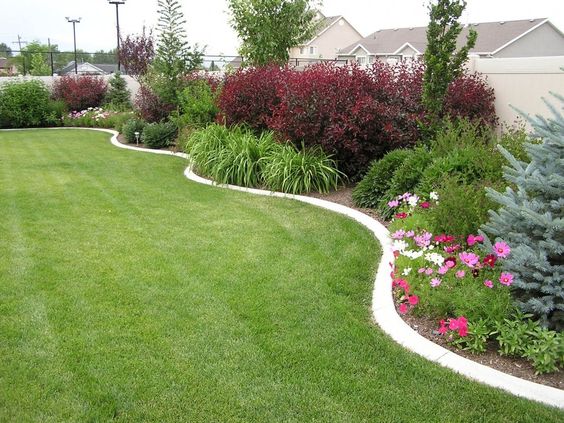
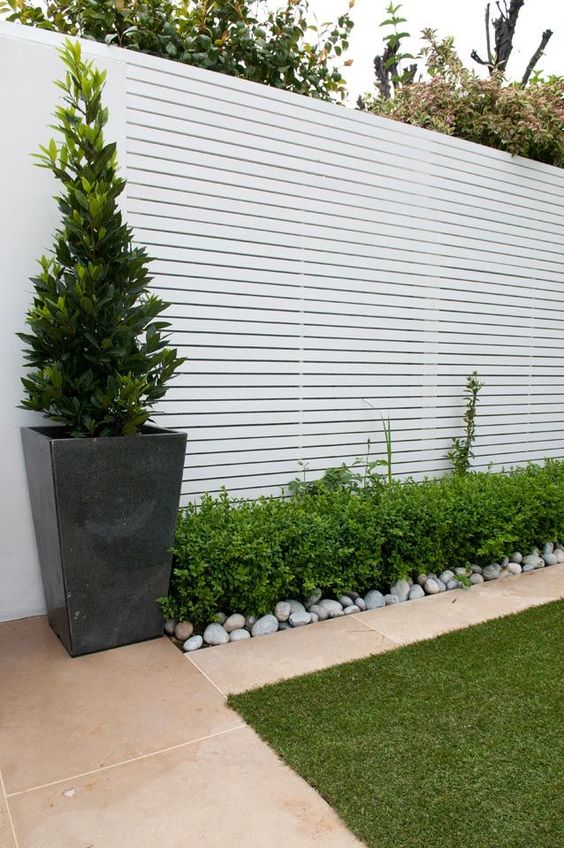
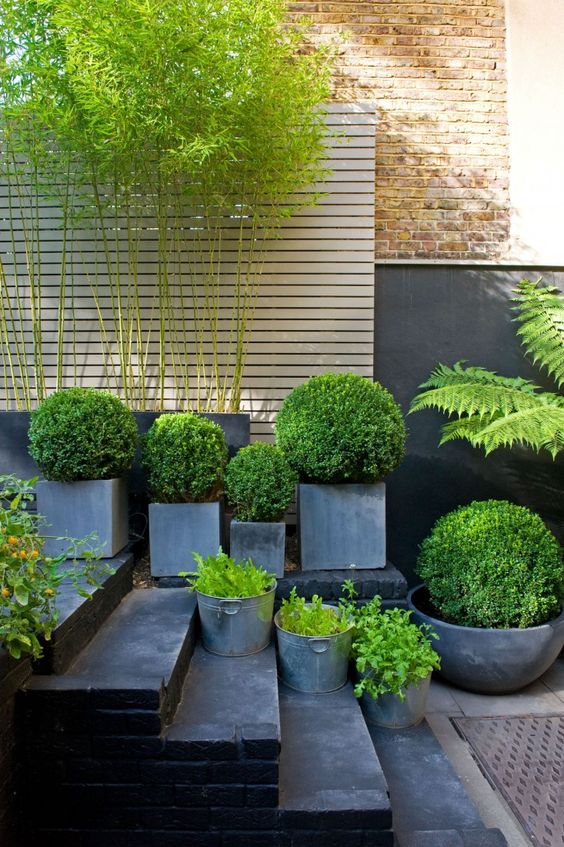
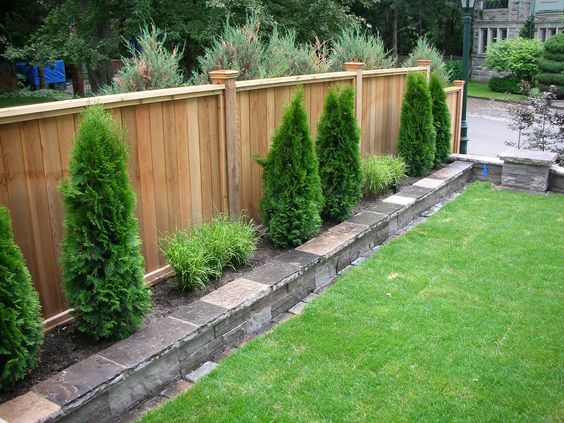
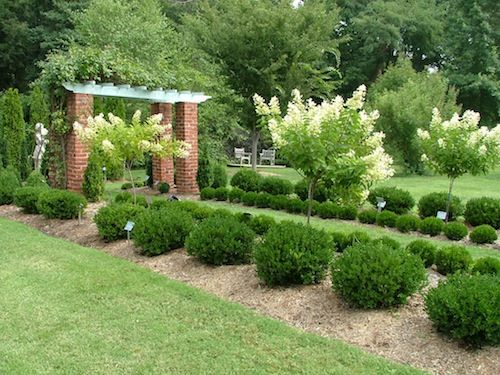

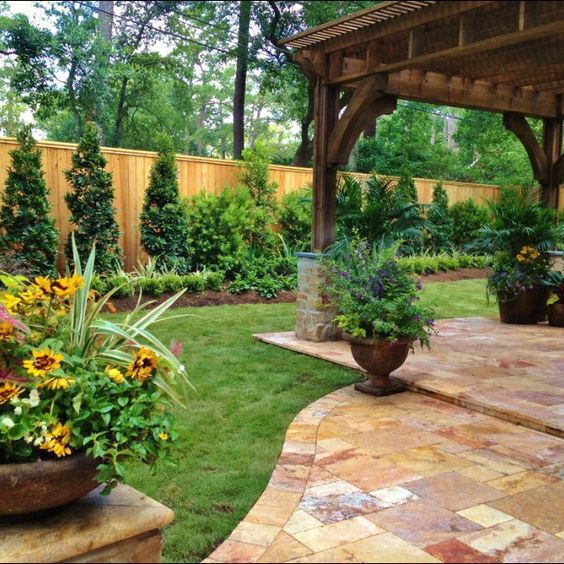
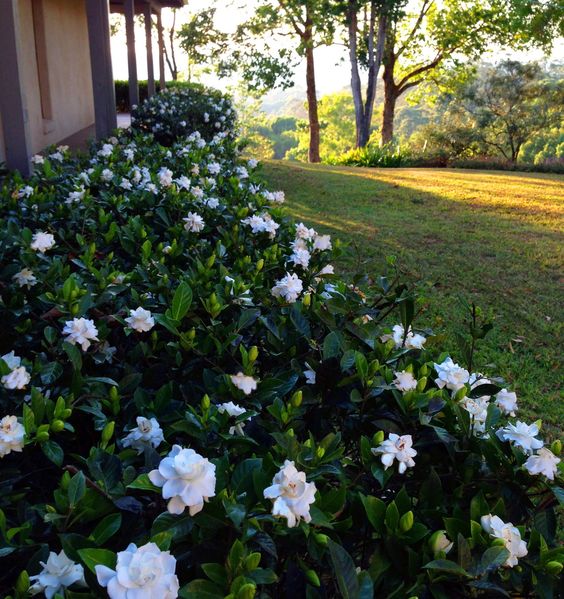

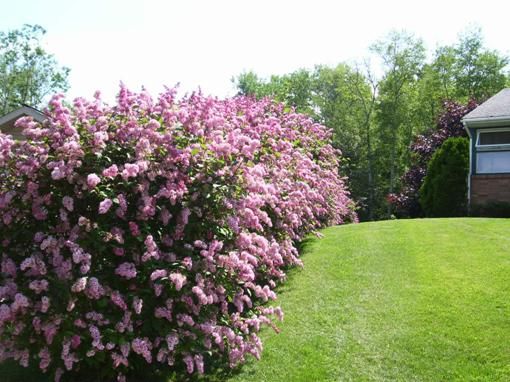

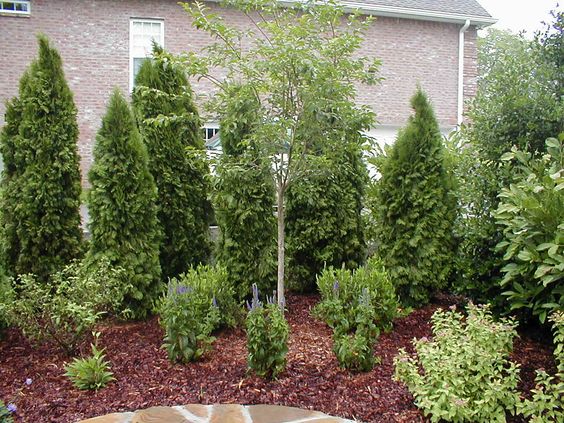
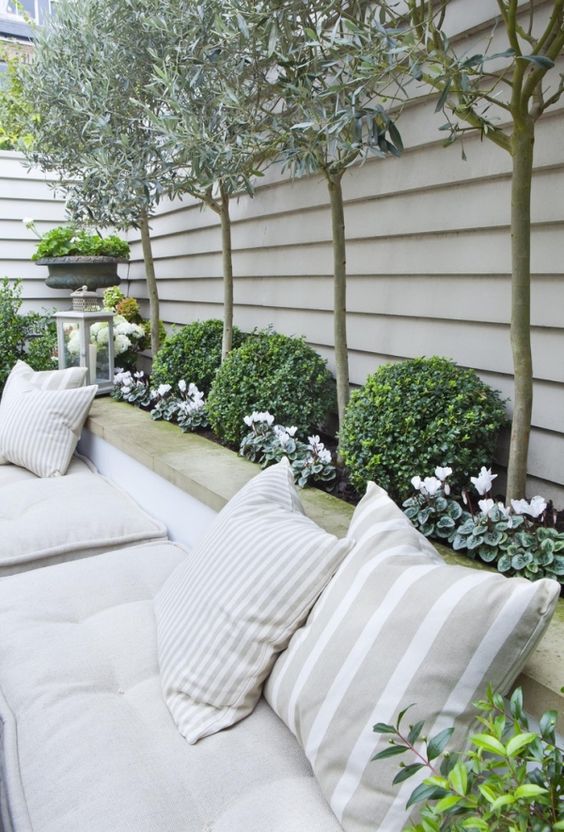
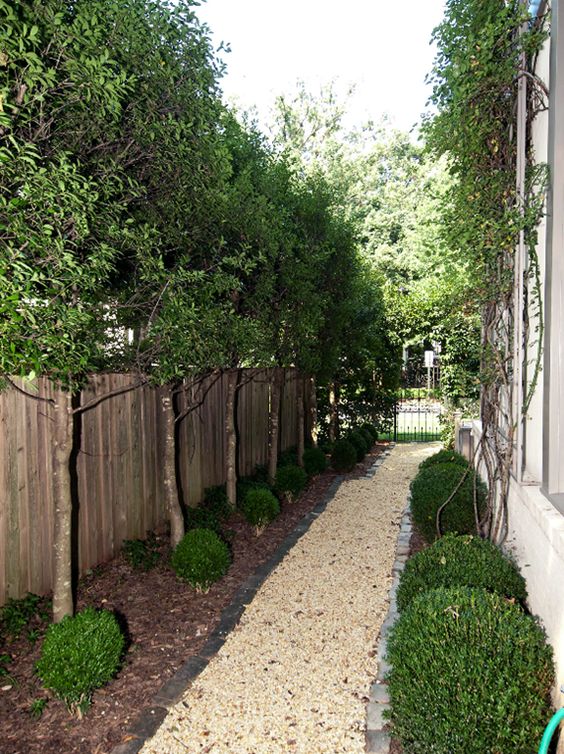
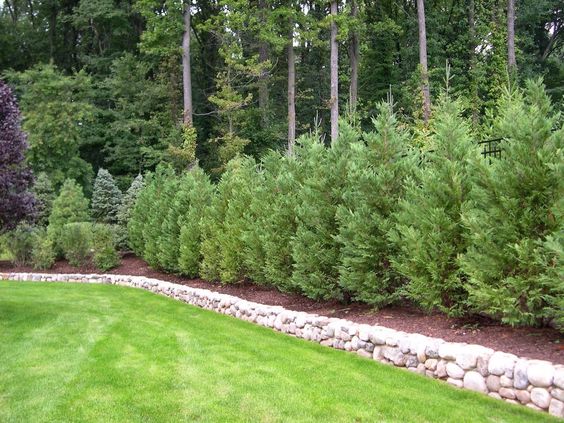

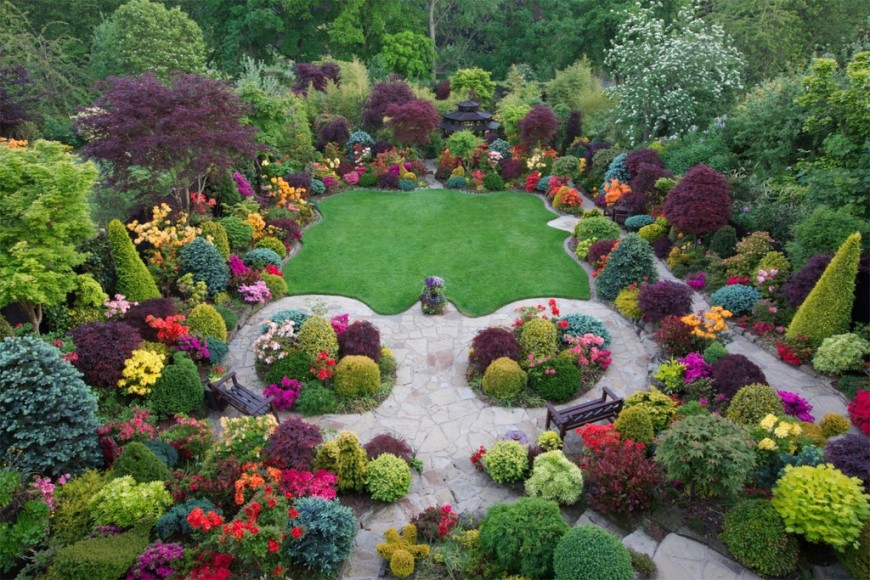

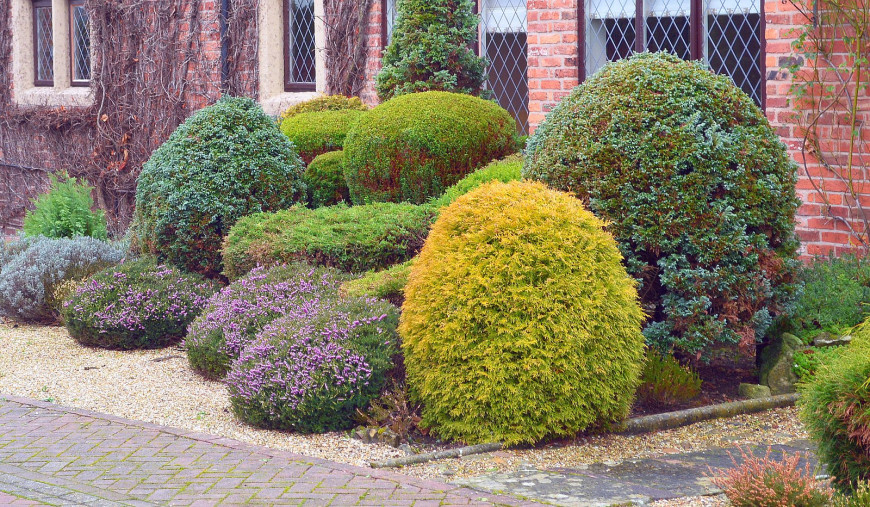
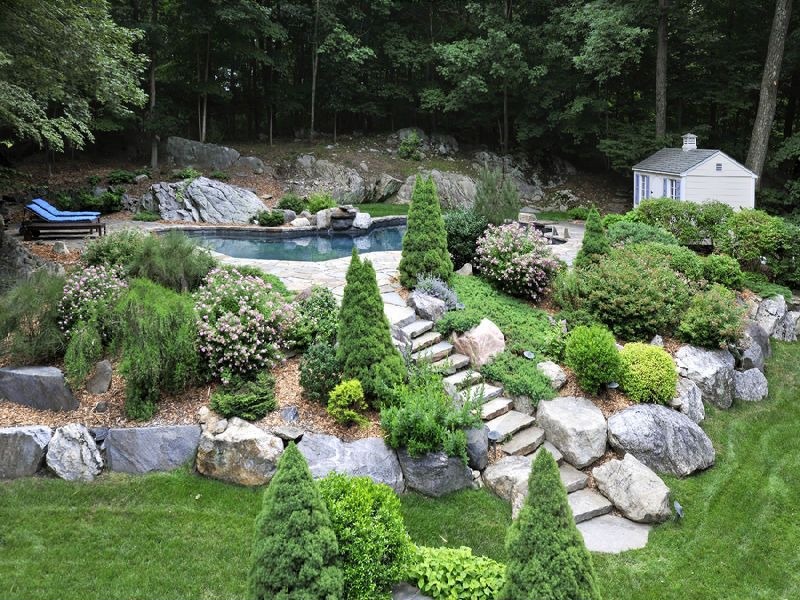
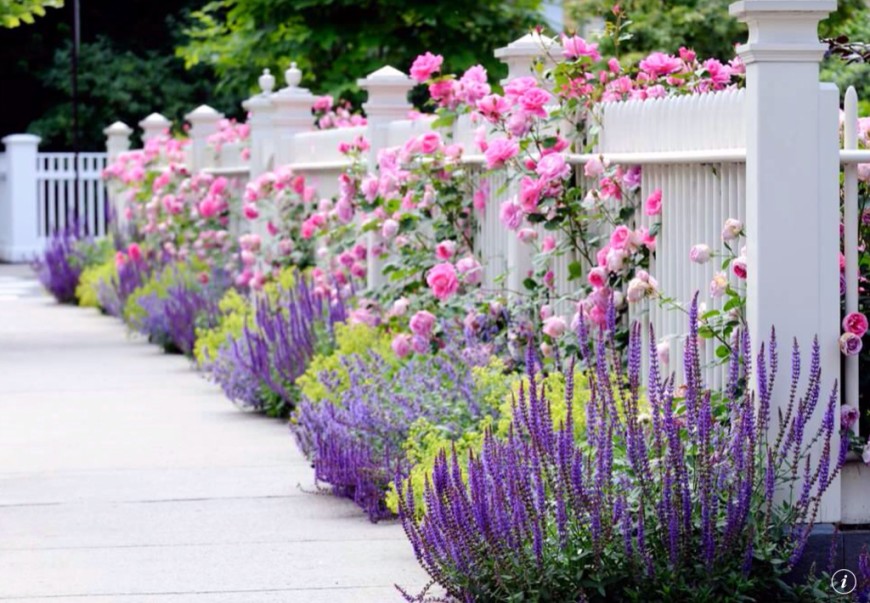
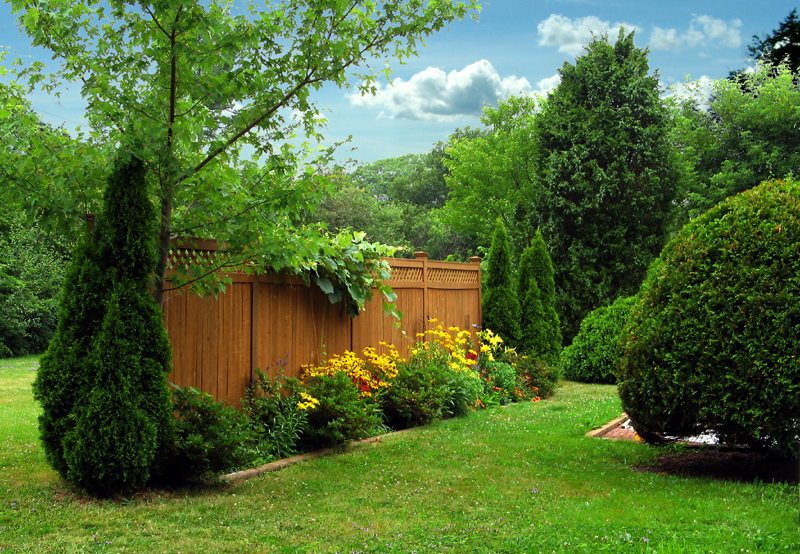

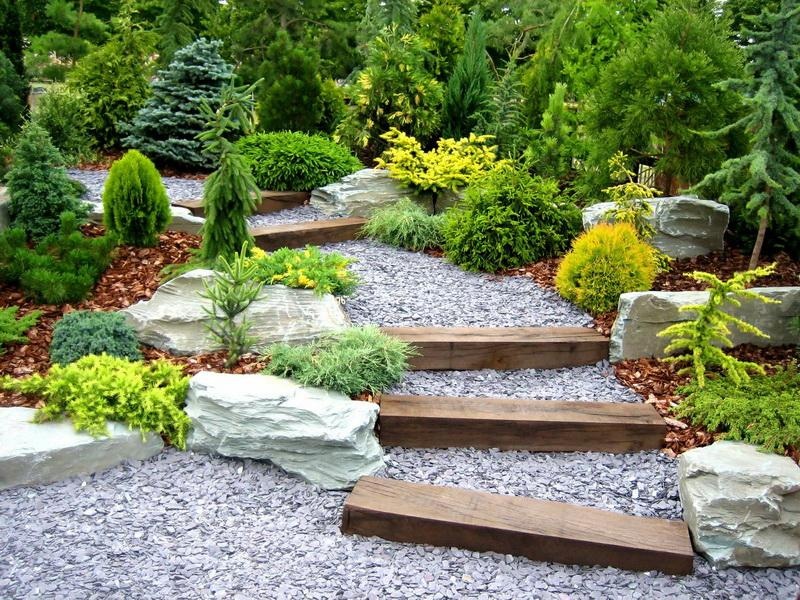
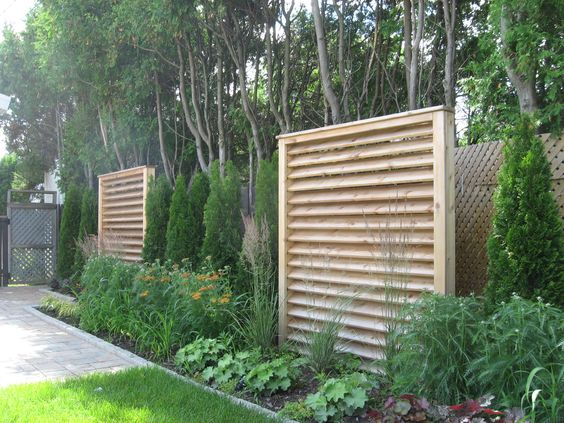

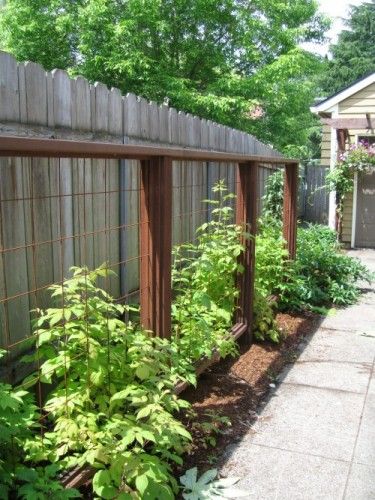

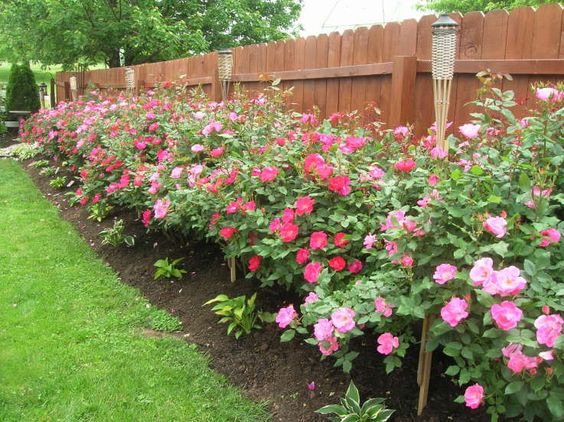
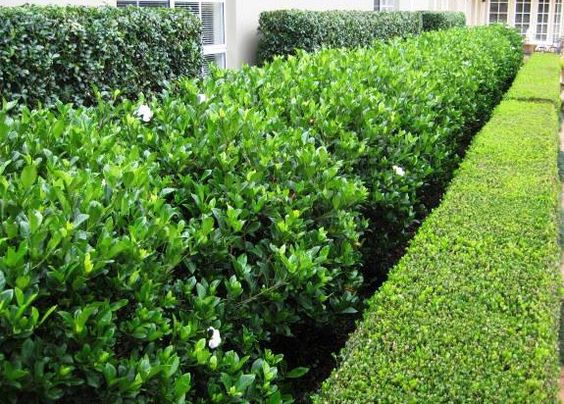


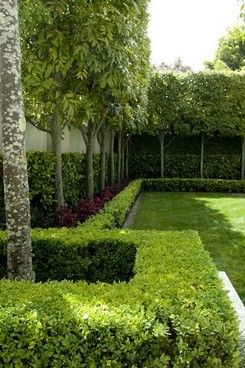


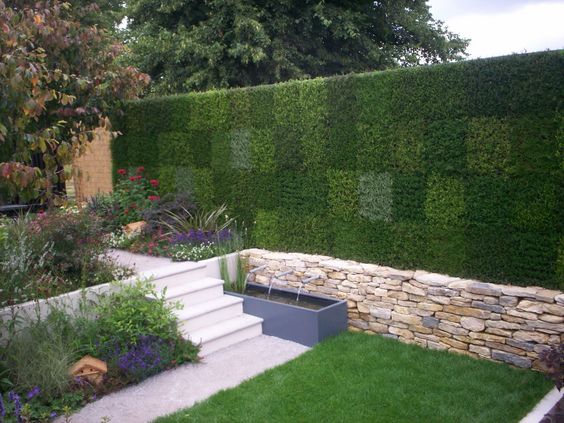
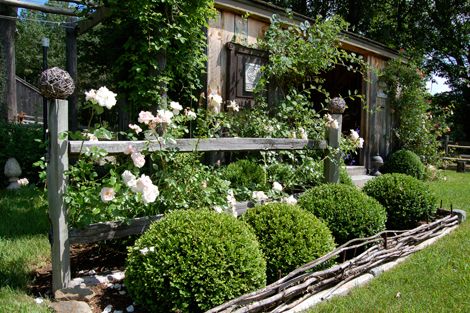
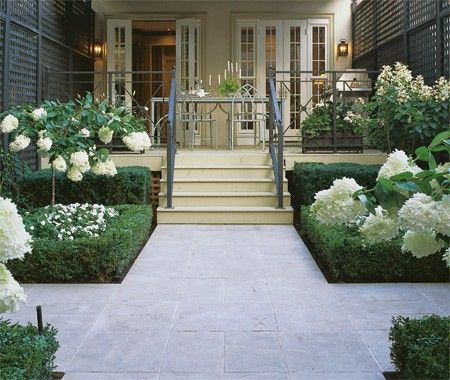
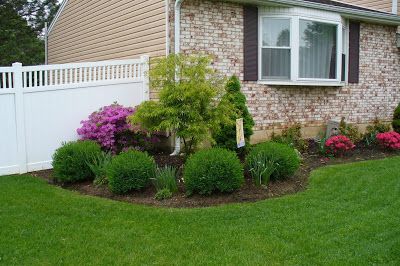
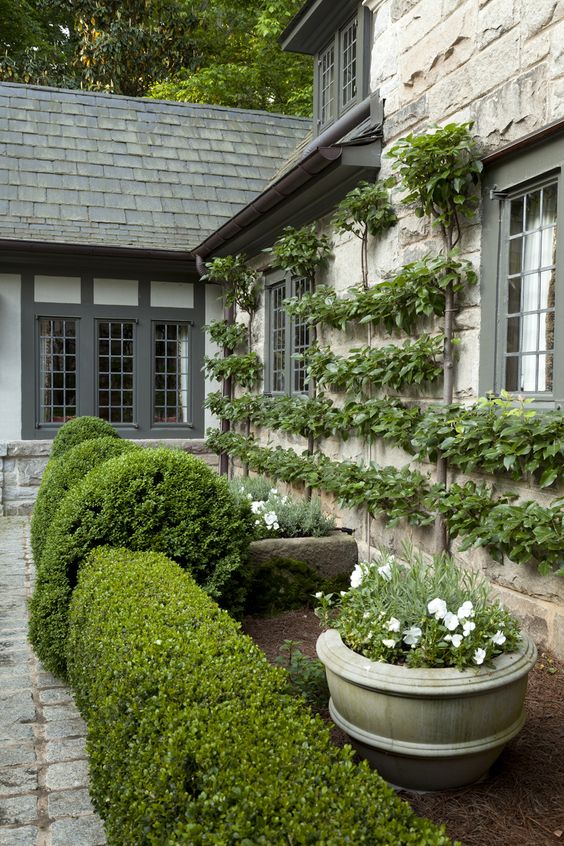
![]()


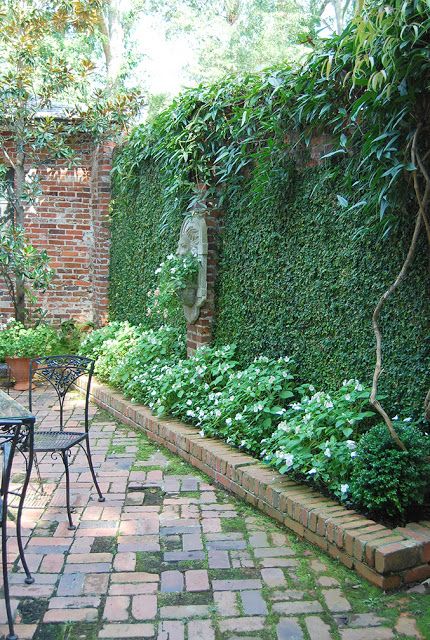
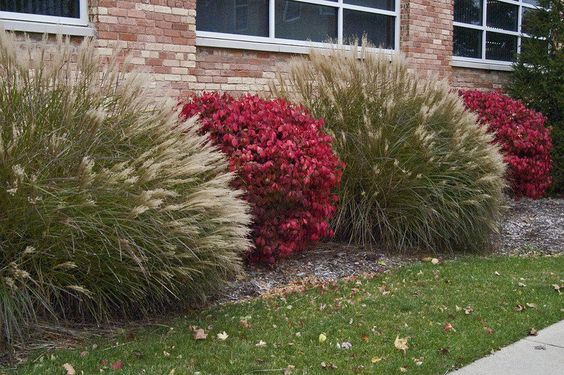
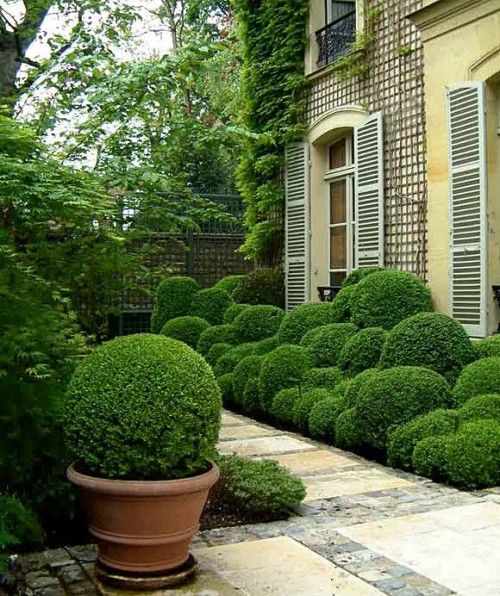
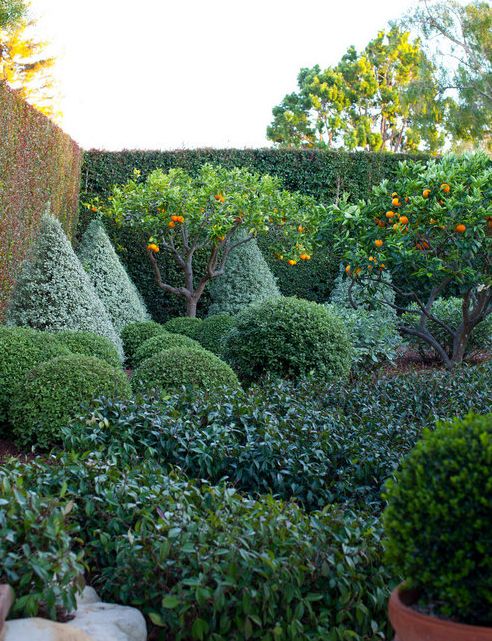
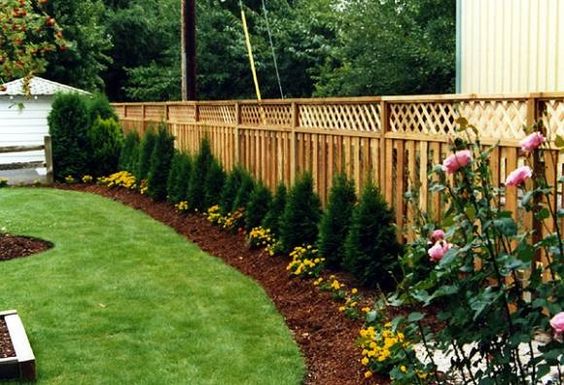


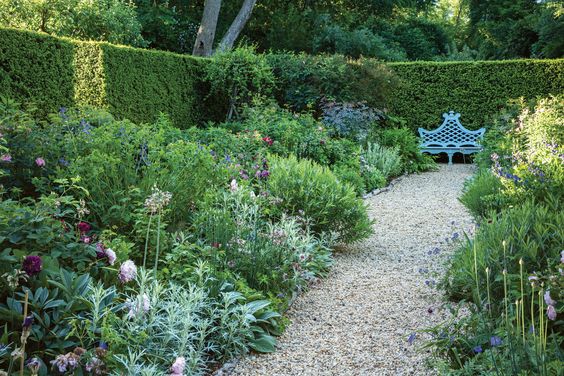

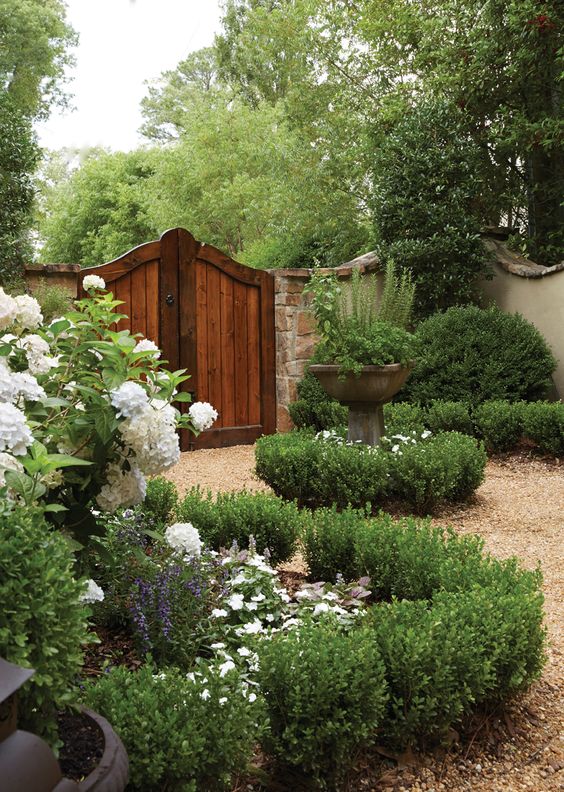
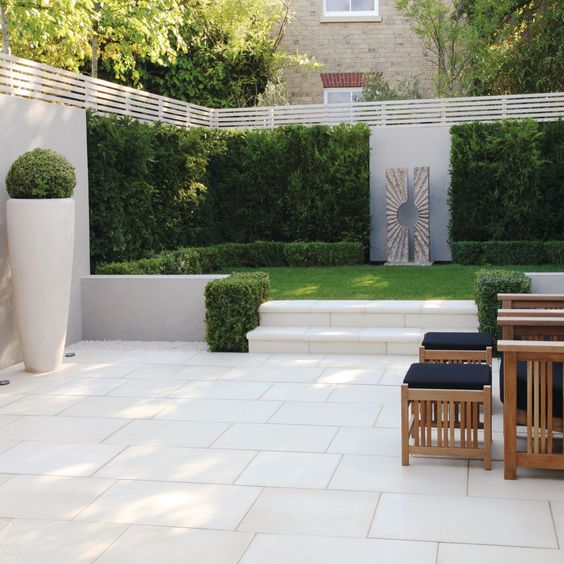
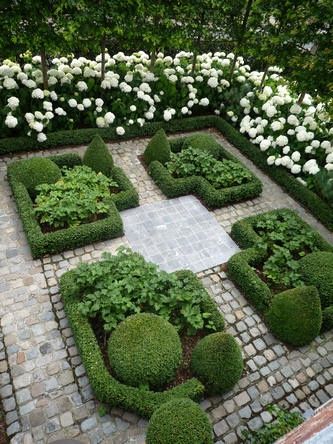


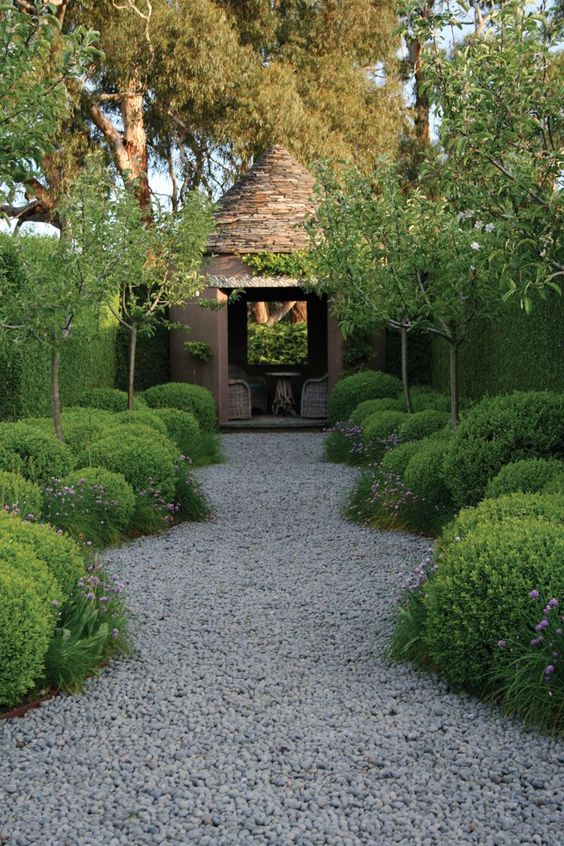
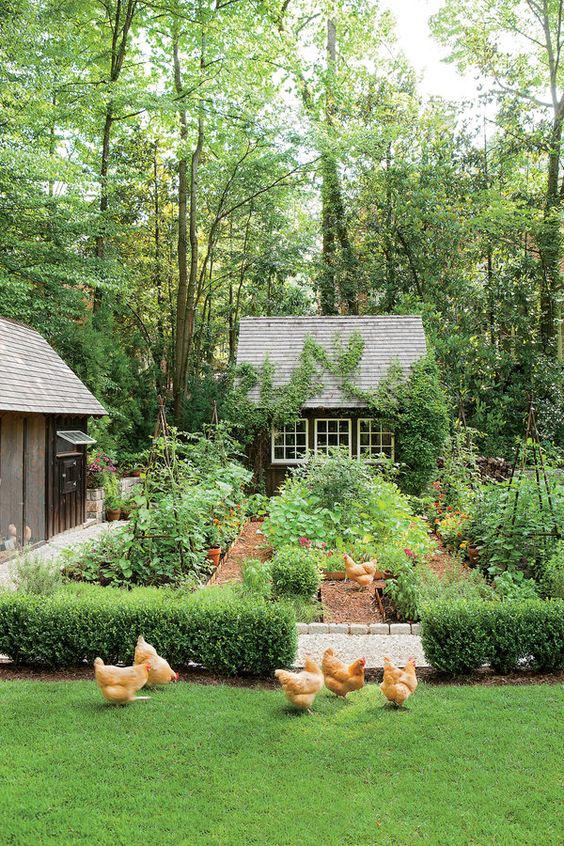
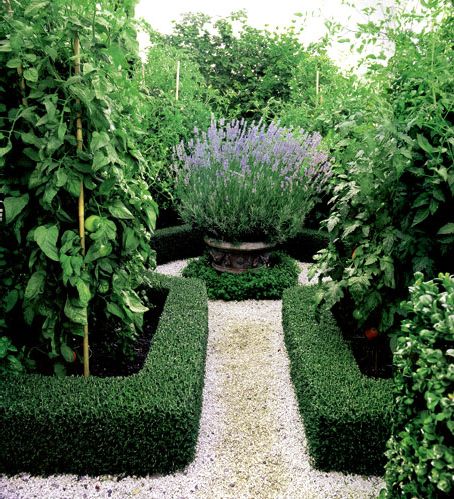
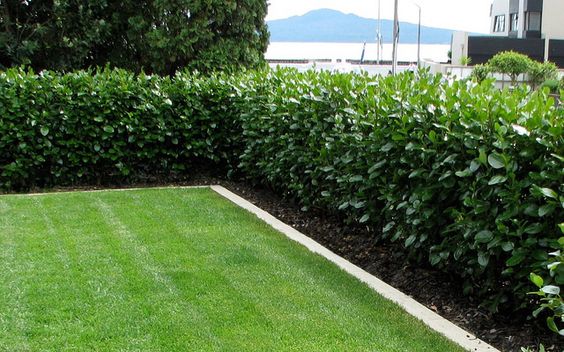
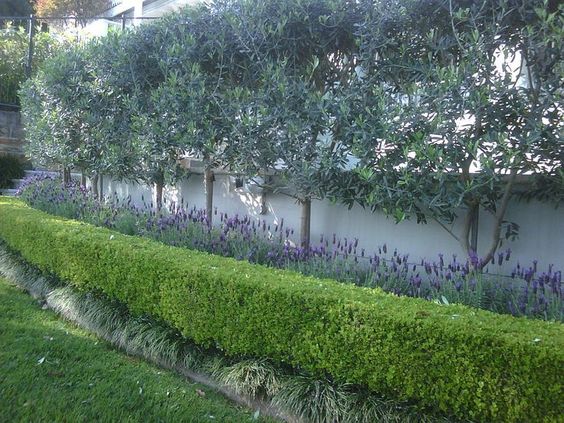

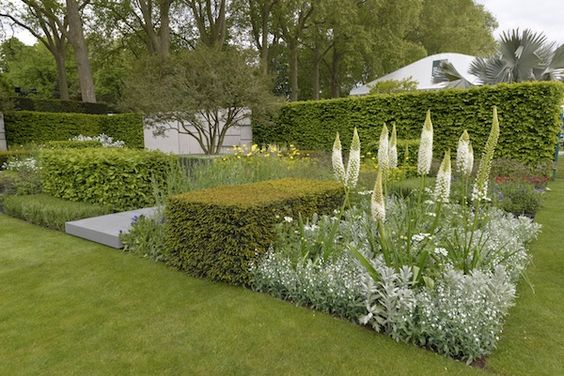
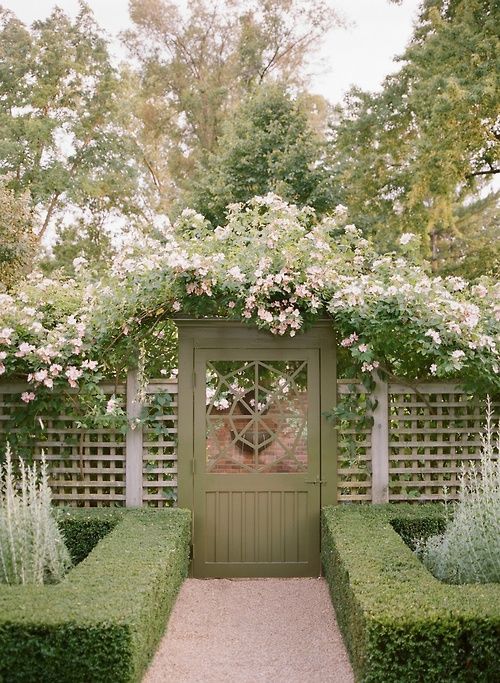
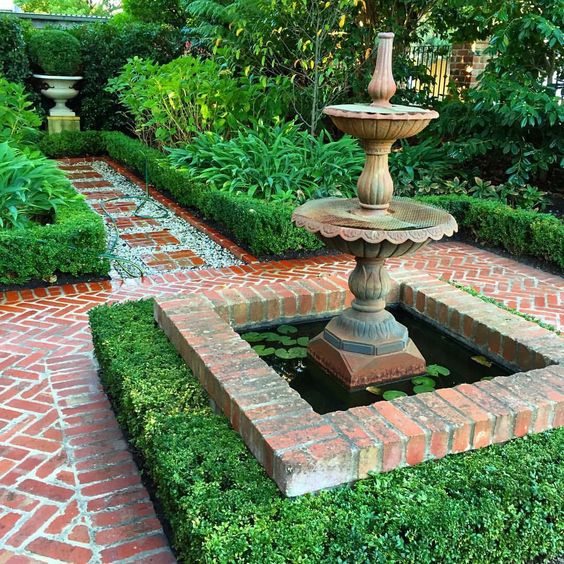
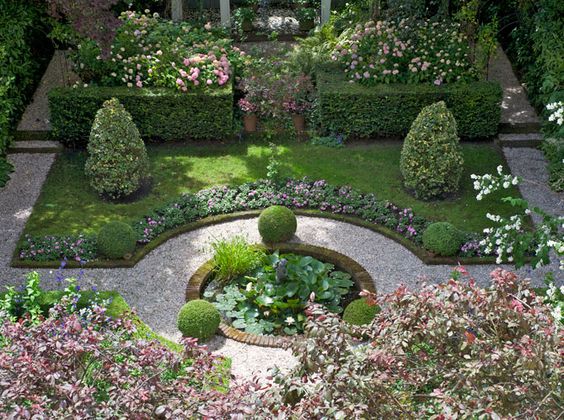



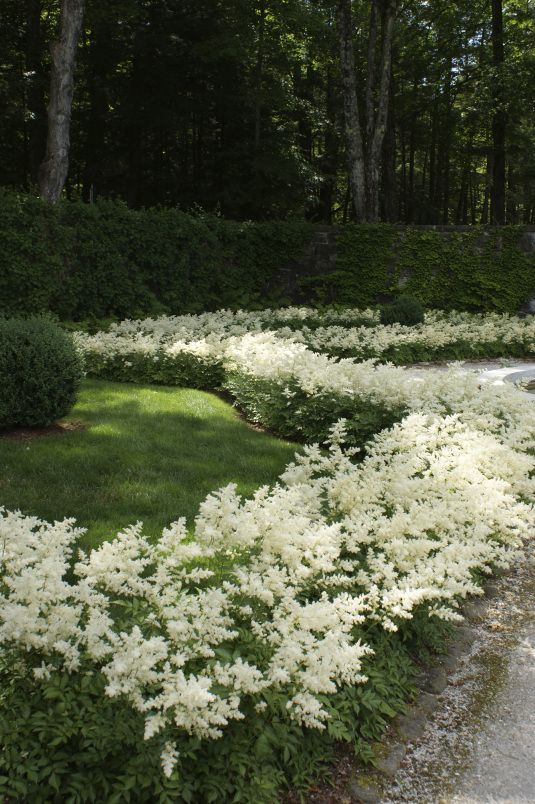
Video
Cottage makes a favorable impression only if the owners care not only about the comfort in the house, but also about the beauty of the whole farmstead. Well, how can we do without the green border along the entire plot?
True, the landings along the fence should not be random, they also obey the rules of landscape design.
- What area along the fence you intend to plant on trees.
- Shadow is side or sunny.
- What exactly do we need plants for - to protect the site or to decorate it.
- How tall are the trees and bushes you would like to see here.
- Should they require special care or better to do with plants "without whims."
- You should know the peculiarities of the soil in which you are going to relocate new settlers and take into account the local climate.
- And be sure to keep in mind: a small dacha should not be overloaded with massive plants.

This is when flowers and shrubs are combined. You can plant thuja, juniper and other coniferous species. Dwarf varieties of trees and bushes will also be appropriate. And necessarily - a riot of flowers, which are selected so that their bloom fell at different times. These will be wonderful bright spots that attract attention.
But with such landscaping you need to take into account the state of the fence, which also will not go unnoticed. So before embarking on landings, the fence should be put in order.
Flowers along the fence will be good both in the form of complex compositions, and in the form of simple flowerbeds with simple plantings.
And you can bet on tall flowers. For example, plant dahlias in front of the fence. These bright large flowers will always distract passers-by from the desire to look into the courtyard.
Shrubs
And yet, most gardeners tend to decorate fences with more “solid” plants. For example, the bushes can disguise a nondescript fence, reliably isolate themselves from their neighbors. They are easy to care for. As a rule, they do not twist the fence and do not spontaneously grow over the site.
Which bushes are best planted along the fence? Among the most popular - Derain. He has an unusually interesting color with a silver bloom. And if you locate low hvoyniki nearby, the composition will be very interesting.
Derain is easy to cut and shape. It is perfectly formed, quickly forms reliable protection from dust.
If you plant a sapling in the spring, then by the beginning of autumn it will be a meter height. Many are attracted by such a newcomer, but it must be borne in mind that the Derena needs a decent living space. Therefore, if you want to see more along the fence different shrubs, you need to look at other species.
A good idea is to plant the barberry Thunberg along the fence. These bushes of a beautiful spherical shape reach a height of 90 cm. When the autumn comes, the opaque leaves acquire a red-yellow shade. The fence at this time looks very impressive.

When planting, it should be noted that the barberry does not like shaded places, reacts poorly to the cold north wind, so it is better to have it on the west or south side of the fence. But with watering at the gardeners will not be problems: the barberry is enough rainwater.
Derain and barberry poorly tolerate the neighborhood with each other, as they have different requirements for the composition of the soil and the amount of moisture. Some of these bushes will not demonstrate their best decorative qualities.

And what is bad spiraea, which is also otherwise called calypodia? It also grows quickly, just a few months after planting, bushes covered with lush foliage form a full-fledged hedge.
But to complete the picture, the spirea will certainly need to be cut so that it is not shapeless.
Look closely at such famous shrubs as lilac, hawthorn, elderberry, black chokeberry. All these plants are fast-growing, capable of hiding the fence in a short time. You can plant them in groups, and in front of them - lower trimmed bushes. Very original options can come out.

Well, if the owners want to combine business with pleasure, then along the fence they can land berry bushes. Then you and the fence, and the annual harvest of raspberries, currants, gooseberries, wild rose.
Very important! Shrubs should not be placed close to the fence. When planting, dig pits at a distance of 1-2 meters.
Trees
The usual picture: on most suburban areas along the fences grow fruit trees, performing a double function: they serve as a fence, and regularly bear fruit. Recently, however, gardeners are thinking not only about the benefits, but also about the beauty, they seek to surround their possessions. ornamental trees. They plant luxurious maples, chestnuts, modest willows, birches, lindens.

But you can probably call the favorites of gardeners coniferous treesespecially ate. However, by this the summer residents restore the old tradition - decorating the farmsteads with conifers.
It is necessary to do this spontaneously. To make the composition of young Christmas trees really beautiful, you need to plant them at a distance of about 30 cm and monitor their development, constantly cutting them in width and height.
How to plant trees
The first line you need to land low conifer. This can be, for example, blue spruce. And tall trees will remain in the background.
Deciduous trees that have creeping crown (birch, willow), you need to plant in the background, and pointwise.
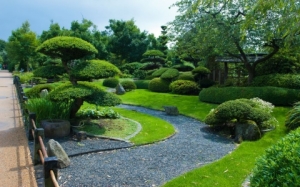 Trees and many shrubs, as a rule, have an advanced root system, so there should be at least 3-5 meters between seedlings and a fence, otherwise the roots will destroy the main fence over time.
Trees and many shrubs, as a rule, have an advanced root system, so there should be at least 3-5 meters between seedlings and a fence, otherwise the roots will destroy the main fence over time.
This is also important because the fence will shade young plants, which will affect their growth.
It must be remembered that in the process of development, the roots of trees grow, cling to each other. That's why it is best to plant trees should be in a pre-excavated trench in one row. This method will give a good result: the trees along the fence will make a flat thick line.
How to choose plants for the fence
The main fences, near which plants are to be planted, come in various types. And for everyone you need to choose the right trees, shrubs or other planting.
Rabitz
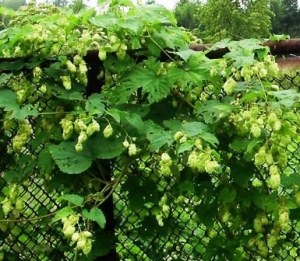 One of the most popular types of dacha fence. Not the worst option, but sometimes its transparency does not suit the owners of the plots. They want, for example, to isolate themselves from curious neighbors.
One of the most popular types of dacha fence. Not the worst option, but sometimes its transparency does not suit the owners of the plots. They want, for example, to isolate themselves from curious neighbors.
It has a design that is convenient for climbing plants. There is, however, a drawback: you have to be especially careful to ensure that the grid does not deform under the solid weight of the vines and does not rust.
It quickly forms a green barrier hops. But it really hurts: very soon the land and the neighboring one will be flooded with land. To deal with shoots is quite difficult.
It is more practical to plant girlish grapes or echinocystis along the fence. They also grow fast, but they are easy to remove.
A good option to securely close the grid is to sow the beans as thick as possible. Or, for example, plant a Jerusalem artichoke under the fence - not only a high fence will grow, but also a crop of useful root crops.
 Any shrubs will feel good about themselves. This may be, for example, hawthorn or elderberry. Any liana will grow (grapes, hops).
Any shrubs will feel good about themselves. This may be, for example, hawthorn or elderberry. Any liana will grow (grapes, hops).
Fruit trees are also relevant (cherry, plum). You can plant hydrangea, barberry, lilac, thuja. All of them are unpretentious and attractive.
Fence of steel corrugated or corrugated
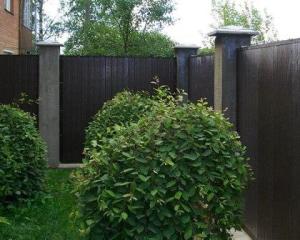 Strong plants should be planted along such a fence, as the fence material will heat up from the sun's rays, and the plants may not withstand such a heat attack. And best of all before planting plants to paint such a fence.
Strong plants should be planted along such a fence, as the fence material will heat up from the sun's rays, and the plants may not withstand such a heat attack. And best of all before planting plants to paint such a fence.
By the way, many gardeners dispute this opinion and believe that along such a fence, jasmine, lilac, raspberry, and many lianas feel great.
What to plant along the fence from the street
 These plants will have one purpose: to hide the area from passers-by. But after all, this goal should be achieved in a beautiful way? And it will be so if you plant low trees along the outside of the fence: pine, spruce, chestnut, birch, and cut it as you grow.
These plants will have one purpose: to hide the area from passers-by. But after all, this goal should be achieved in a beautiful way? And it will be so if you plant low trees along the outside of the fence: pine, spruce, chestnut, birch, and cut it as you grow.
Lilac is also suitable in this place, but you have to make sure that during the flowering “lovers of beauty” do not break branches.
When to plant trees and shrubs
It doesn’t matter if you plant or transplant plants - it’s better to do it in the autumn at times. Experts practice and winter landing, but it is a task unbearable for summer residents.
There is such a pattern: decorative bushes, which bloom in the spring, - plant in the fall; if you bloom in late summer - you can plant in spring. As you can see, for most shrubs planting dates are still autumn.
This season is also good because you don’t need to hurry, fearing that the buds are about to bloom. The main thing in autumn planting - so that the seedlings can take root to severe frosts. Well and in middle lane It’s difficult to guess the cold weather, so it’s better to complete all the landing work by mid-October.
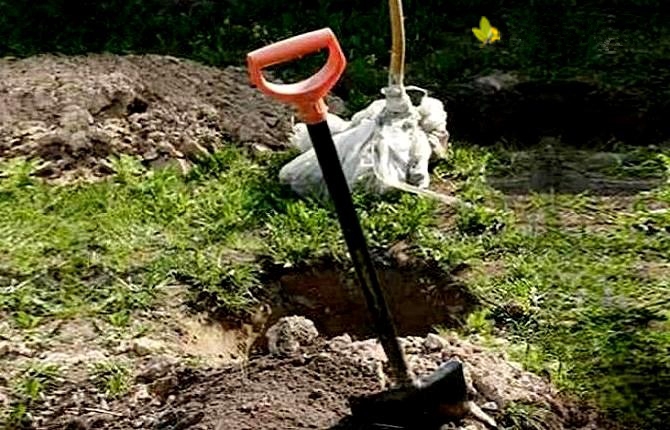
If for some reason the trees or shrubs could not be planted by this time, you can take a chance and do it a little later. But at the same time the roots need to be protected from the cold. They do it this way: the near-stem circle is richly mulled by peat, sawdust, leaves, etc.
If it's cold outside, planting trees and shrubs is impossible. They need to give a sloping position, prikopat earth and sprinkle with mulch. And on permanent place plant with the onset of spring.
It is easier to deal with plants that are grown in containers. They can almost be planted at any time. The exception is evergreen bushes and trees or plants that bloom at that moment.
Video: A beautiful fence of flowers. Flowers on the fence
The article will help you choose plants for planting along the garden paths. What plants are better, decorating steps.
In combination with a garden path
Before you begin to decorate the garden path (Read the article "How to make a garden path"), you need to think in detail what plants will be better in harmony with it. To do this, consider the material from which the track is paved, what color it is. For example, if the garden path is lined with orange tiles, you can pick plants of the same color, such as marigolds or calendula, or, conversely, shading this color.
If you want to hide a nondescript gray color, then you need to pick up such plants so that all attention is paid only to them.
Plants along the garden paths can be planted annuals. If every year there is no desire to decorate the path, then it is best to pick perennial flowers or decorative leafy plants.
If, on the contrary, it is necessary to show the beauty of the path, its unusual paving, you can sow strips of lawn that will very clearly emphasize the lines of the path. And after the lawn you can plant flowers. Air-like irises, hosts will look very nice.
At the corners of the intersection of the tracks can be broken flowerbed with rounded lines. It would be better if such a bed will consist of widely growing flowers, for example, from ground-covering roses.
What plants are better?
To unequivocally answer what kind of plants are best planted along a garden path is difficult, since this is the business of every gardener, his love for certain plants. Nevertheless, there are a number of recommendations in solving this problem. For example, a very good solution - landing at the edges of the track different varieties daylily. Daylily can be of very different colors: burgundy, brown, yellow, orange, violet - all these colors will either be combined with the track or shade it. In addition, the peculiarity of the daylily is that one variety fades away and the other begins to bloom. Thus, along the path there will always be beautiful flowering plants.
If u track grass curbthen small bushes of decorative cereals, sedges, often having variegated leaves, decorative inflorescences, will do.
Evergreen periwinkle is very popular with gardeners. This plant will decorate the track with its bright greenery almost the entire season. In June, the periwinkle blooms with beautiful blue flowers.
Beautiful along the paths will look different bulbous plants, such as hyacinths, crested, tulips, but it is only in the spring. But unpretentious daisies delight their bloom from summer to autumn.
Along the tracks - landing in tiers
Planting of plants in tiers will add amazing beauty to the garden path. The peculiarity of this planting is that each tier is decorated with certain plants, selected by color, height, and foliage.
The first, lower tier, as a rule, consists of creeping and stunted plants. Here you can include, for example, a different type of stonecrop, thyme, zhivuchki, lungwort, undersized hosts, periwinkle, saxifrage, primroses, phylum styloid, antennaria, monkeys.
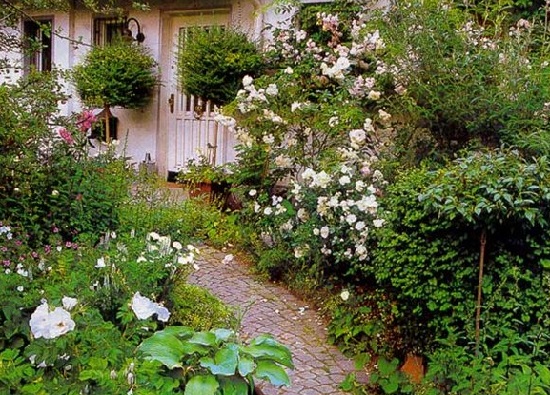
To create a second tier, medium-grown plants are selected. This is a fishery, Badan, creeping hvoyniki, high primroses. You can use yearlings.
The background is made up of higher plants. Beauty will be given to him by such plants as astilbe, phlox, paniculata, lilies, daylilies, jois, and fowlaris. Column-shaped conifers will give a finished tier.
When creating longlines, it is necessary to select plants so that they combine with each other, do not overlap each other.
Decoration of steps and ledges
On uneven garden plots, with frequent differences in height of the track, they pass into ledges, in steps. To decorate them, you can plant low or creeping plants. This will visually smooth the unevenness of the site.
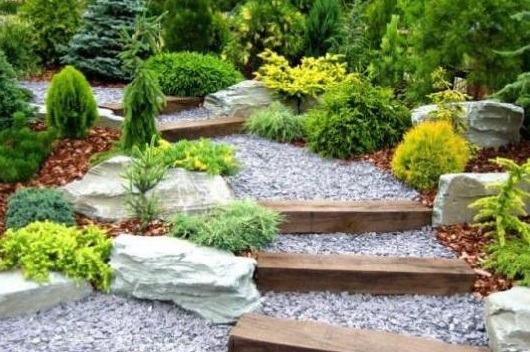
The steps can also be decorated with flowers, moreover, this can be done so that the shape of the walkway changes visually, for example, to make a smooth flight of a staircase or a smooth walkway curved. For this plant must be planted so that they waddle over. Such a plant besides beauty still fixes the soil, prevents its erosion. This function can be performed well by the small-scale bloom. His little white and pink daisies bloom all season. It reproduces by self-sowing, and due to short stature it can sprout in any crack, thus hiding defects in the work when paving paths.
Bending the track can be visually created if you plant a large plant that would cover the continuation of the track.
The fence around the local area or suburban area is a necessary thing. It not only indicates the boundaries of possessions, but also protects the landing from visiting the territory by unwelcome neighbors pets.
Also, the fence can be an artificial protection from the wind for many plants. We will try to figure out what to plant along the fence, so that this protective structure looks attractive. Plants can be both from the inside and from the outside of the fence.
What trees to plant along the fence
Trees for planting outside the fence
Trees from the outside of the street, besides the aesthetic function, play the role of a kind of filter that traps street dust and exhaust gases. For the outside of the fence will fit trees that are well maintained pruning and are not too valuable or rare, it will help avoid vandalism. In addition, you need to choose plants unpretentious and resistant to frost, drought and other adverse conditions. For these purposes, most suitable:
- fine-leaved elm
- common elm
- rowan
- river maple
- tatar maple
Elm
In the wild, common elm is common in deciduous forests almost everywhere. It is found in the European part, in Siberia, in the Caucasus, in the Baltic States. In Kazakhstan. In height, the tree grows up to 25 meters. The plant is shade tolerant, drought resistant.
In landscaping, elm has been used for a very long time, due to the fact that it not only tolerates a good haircut, but also keeps its shape well. It has many decorative forms:
- silver motley
- golden motley
- red
The disadvantages of elm can be attributed to the demanding of the fertility of the land. On poor soils, the growth of these trees slows down. In addition, elms can attract unwanted pests and actively damage them. The undoubted advantage is that the common elm lives for a very long time, up to 200-300 years.
Ephedra for the inside of the fence
From the inside of the fence, you can plant coniferous trees with slow growth and with decorative needles and crown. In addition to decorative, coniferous trees clean the air and emit healthy phytoncides. In the summer, to create a contrast with the dark needles near the plantings you can plant bright annual flowers.
For landing near the fence from the inside fit:
- stunted spruce species
- medium-grown species of common spruce
- ornamental species ate gray
Spruce Acrocona
In the year, this species grows no more than 8 cm, the adult plant is no more than 3.0 m in height. The crown is conical, with a broad base, up to 4.0 m. needles saturated green color. Young cones of pink color make trees elegant and attractive. This species does not tolerate dry soils with increased salinity.
In addition to spruces, along the fence you can grow undersized thuya, larch. Despite the diversity of species and varieties of conifers and deciduous trees, most of the owners of sites at registration of fences prefer unpretentious bushes.
Shrubs for growing along a fence
The selection of shrubs for growing along the fence is very large. Among them, you can choose the species with a long flowering period, fruiting, prickly. Along the fence can be planted:
- barberry
- spiraea
- chokeberry
- kuril tea
- lilac
- decorative cherries
- dog rose
- Barberry
It is very convenient to plant ornamental species of barberry along the fence; this shrub is unpretentious, tolerates any pruning, has thorny branches, which serves as additional protection from unwanted visitors. Among all the barberries can be distinguished decorative varieties Thunberg.
Barberry Thunberga purple
This deciduous shrub differs moderate, up to 1.5 meters in size. The shrub has flexible, arcuate shoots. Differs beautiful purple foliage in early summer. The flowers are bright yellow, clustered in a brush. The flowers have a very pleasant aroma.
The berries are red, long kept on the bushes. This preserves the attractiveness of the barberry with the onset of winter. During the growing season, dark purple leaves gradually brighten with spots of yellow, orange, green. The plant is unpretentious to the composition of the soil, hardy and drought tolerant. Due to the long, up to 1 cm, thorns creates impassable thickets.
Sand Cherry
This type of decorative cherries has an attractive appearance throughout the season. In the spring on the reddish shoots appear large, about 1.8 cm in diameter, white flowers. They are very fragrant, collected in bunches of three flowers. The height of adult plants is about 1.5 m.
In place of flowers, quite edible fruits of black-purple color are formed. The leaves by the autumn get orange-red coloring. You can plant along the fence in combination with spruces. It grows very quickly, undemanding to irrigation and soil composition. In recent years, the plant is gaining popularity due to its decorative qualities.
In addition to trees and shrubs, along the fence can be various climbing and creeping plants.
Curly shrubs for planting along the fence

Climbing plants can be an excellent design of the fence from the inside and outside. Along the fence can be planted:
- honeysuckle honeysuckle
- hop
- girlish grapes
- clematis
- actinidia
Honeysuckle Capricole
In the wild it is common in the middle and southern regions of Europe, in the Caucasus. In ornamental gardening valued for its rapid growth and charming appearance throughout the season. Climbing shoots grow to a height of 3-5 m. During the season, young shoots can lengthen by 0.8 m. In good sunlight, they have a red-purple color.
Leaves are oval, dense, leathery. The upper part of the leaf plates is dark, green, the lower - gray. The leaves stay for a very long time in autumn, while retaining their color. For about 4 years the plant is blooming. Flowers of the original form, with protruding stamens.
Inside the flowers are white or yellow, on top of delicate purple. In length up to 5 cm, from afar look like moths with raised wings. The flowering period of 20 - 25 days.
In place of the flowers appear inedible orange fruit. The plant requires the formation of bushes. For this, it is evenly along the fence. To create a support tension cords. So that the plant does not become tangled thickets, it is timely cut off from the top and sides.
Launched bushes pruned near the ground, after which the sleeping buds will give rise to new shoots. Honeysuckle capricole does not suffer from diseases.
Actinidia colomicta
In the wild, this plant grows like a vine in the forests of the Far East. Of all the types of actinidium different decorative color foliage. In early spring, they are of a bronze color, after which they turn green, at the end of flowering the ends of the leaf plates turn white, after flowering, the leaves become crimson.
In autumn, the foliage acquires the most bizarre shades from purple to yellow. The flowers are white, with an unusually pleasant smell, which is felt at a sufficiently large distance. The fruits are edible, the plant itself is a relative of kiwi. Undemanding enough, the peculiarity of care is the shallow loosening of the soil. In addition to shrubs and trees, perennials can be planted along the fence.
Flowering perennials for planting along the fence
Perennial herbaceous plants can become a beautiful and unpretentious design of the fence. For this fit quite tall flowers:
- stock rose
- rudbeckia
- goldenrod
- lupine
Stock rose
This plant has a second name - mallow. Differs quite high, up to 2 m, stem and bright flowers of various shades. Depending on the type of mallow has flowers of white, pink, red and dark cherry color. Flowers can be both simple and double, up to 12 cm in size.
Flowering is long, begins in early July and lasts until the end of September. The leaves are large, up to 10 cm, with jagged edges. Most often, the plant does not require special care, however. Mallow grows poorly in very poor, heavy and overly humid places.
The choice of plants for growing along the fence is very large, here everyone can choose plants according to individual preferences.
Video about which plants to choose for a hedge:
Most gardeners lovers are not satisfied with even the newest beautiful fence and tend to decorate it, breaking flower beds and flower beds or planting more serious plants. Shrubs along the hedge will help to hide from prying eyes, mask the old fence, provide additional oxygen and even useful fruits and berries.
Several types of shrubs planted along the fence
What kind of shrubs can be planted along the fence? And what is to be guided by?
When choosing green plantations, it is not enough to act on a whim, the organization of landscaping should occur deliberately. First you need to answer the following questions:
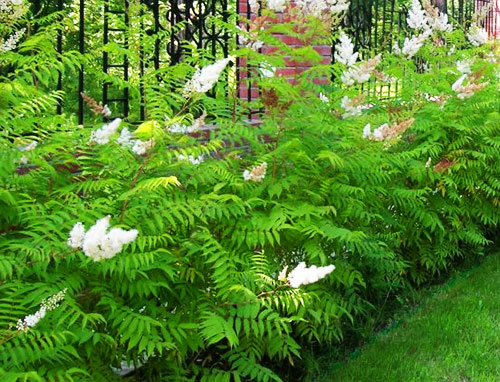
An example of planting ferns along the fence
- planted shrubs will carry a protective or decorative function;
- what will grow out of a bush in the future, its height and spreading;
- how much space can be allocated for plants;
- the sunny or shady side of the fence at the landing site;
- opportunities for the care of plantings (if the owner rarely appears at the cottage, you may need to make a choice in favor of the most unpretentious plants);
- climatic features of the region - not all vending plants are suitable for certain weather conditions;
- soil features on the site.
Why precisely shrubs
The flowers planted along the fence bring in the least of all - beautiful, bright, attractive. But rich colors will attract the eye not only to the colors, but also to the fence, so that all the flaws will have to be fixed.
Shrubs are another matter - they are able to grow to a considerable height and close from prying eyes or hide the unsightly view of the fence. 
In addition, shrubs planted along the fence, have a lot of positive points:
- unpretentiousness;
- easy care;
- esthetics;
- creating a good microclimate, protection from dust and noise;
- saturation of the territory with oxygen;
- durability;
- the ability to change the appearance with a haircut.
Types of shrubs
Which bushes are better to choose, so as not to have strong difficulties in the care? Among the most popular are the following plants:
Derain
The variegated varieties of white turf are very popular for planting in the garden.
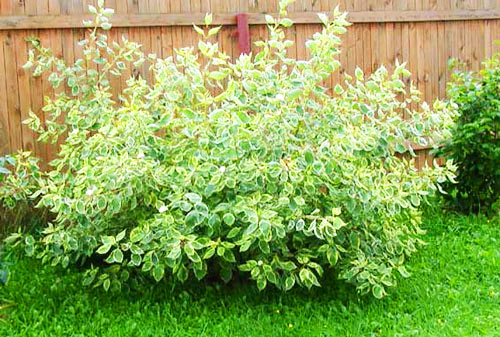
Example of planting a shrub deren at the fence
This shrub is quite common and grows well in the middle lane and Siberia. It is unpretentious, quickly forms a crown, grows well in shady places, tolerates cold winters and even poor ecology. Often Derain is used for urban landscaping.
The shrub grows up to 2.5 m, the leaves are broadly ovate. In the summer, shrubs adorn the flowers. Autumn fruits are white. Particularly beautiful ornamental shrubs with variegated foliage. In addition, the crown Derena perfectly amenable to the formation and cutting.
Spirea
This shrub is presented in a wide range. With a competent combination of different varieties of bushes along the fence will bloom from spring to autumn. Spirea is a shrub of medium height and is 1.5 m. Spirea fences are thick and grow very quickly. A shrub can be formed or left for free growth - decorativeness does not suffer from this at all, on the contrary, it will only bloom more abundantly.
Plants are unpretentious to the soil, winter-hardy, do not need private watering, well propagated by layering. 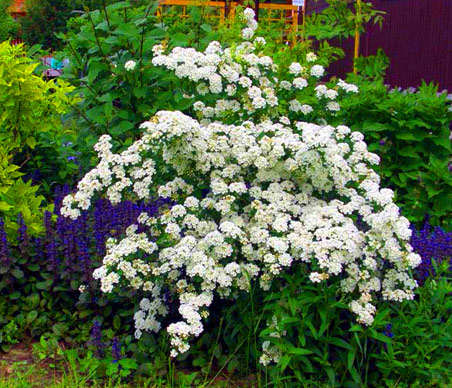
There are varieties with leaves of red or golden color, which will delight with beauty all season. When planting should maintain a distance of at least half a meter.
Lilac
Extraordinarily beautiful and diverse flowering shrubwhich grows well in temperate climates.
Lilac prefers fertile soil and well-lit places with low groundwater levels. There are more unpretentious and frost-resistant varieties - Amur and Hungarian lilacs.
The dignity of lilac bushes - decorative and the ability to choose from different varieties. Of the minuses can be noted a great love of light and active root system breeding. Without care, the bush grows heavily.
Rosehip
Wild rose hedge looks great and tolerates a haircut. Especially good to plant it along the fence from the street. Soon enough, you can get an impassable thorny shrub that blooms very beautifully in spring and is decorated with fruits in summer and autumn.
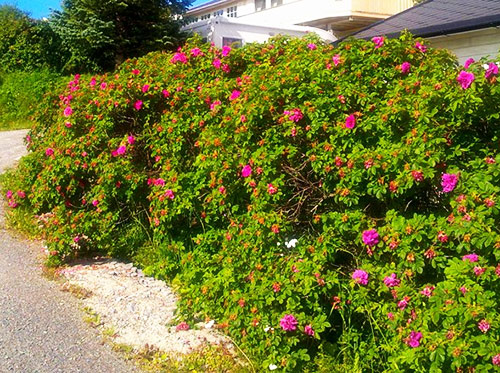
An example of planting a dog rose along the dacha fence
Rosehip very quickly propagated by root suckers, so for a neat look you need to strictly limit the growth of shoots to the side. To do this, you can use constraints from improvised means: slate, boards, decking or specialized garden curbs. Rosehip almost does not need care and fertilizer. The only thing the first 2-3 years should be watered the bushes once a week in hot weather.
Fruit bushes near the fence
Not only to decorate, but also to get benefit, you can disembark along the fence fruit bushes, especially if the site is limited by the number of hundred. For fruit planting will need more care if you plan to take them off a rich harvest.
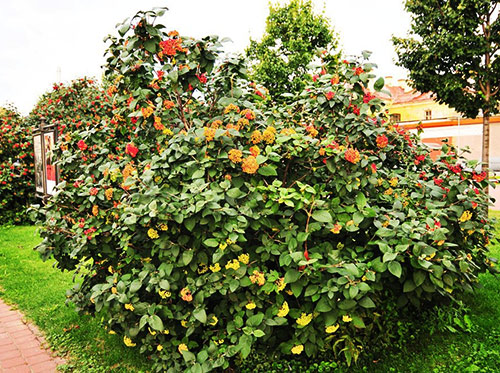
The choice of shrubs that can be planted along the fence is large enough. You should also pay attention to options such as elder, barberry, thuja, hydrangea.
Fence and selection of plants
When planting shrubs along the fence should follow some recommendations:



